Competitive Advantage Strategies and Analysis
VerifiedAdded on 2020/06/03
|20
|6985
|49
AI Summary
The assignment delves into the concept of competitive advantage, examining various strategies businesses employ to gain an edge. It presents a comparative analysis of different models, highlighting their strengths and weaknesses. The analysis is further illustrated using comparative rankings and illustrations to demonstrate practical applications in identifying and achieving competitive advantage.
Contribute Materials
Your contribution can guide someone’s learning journey. Share your
documents today.
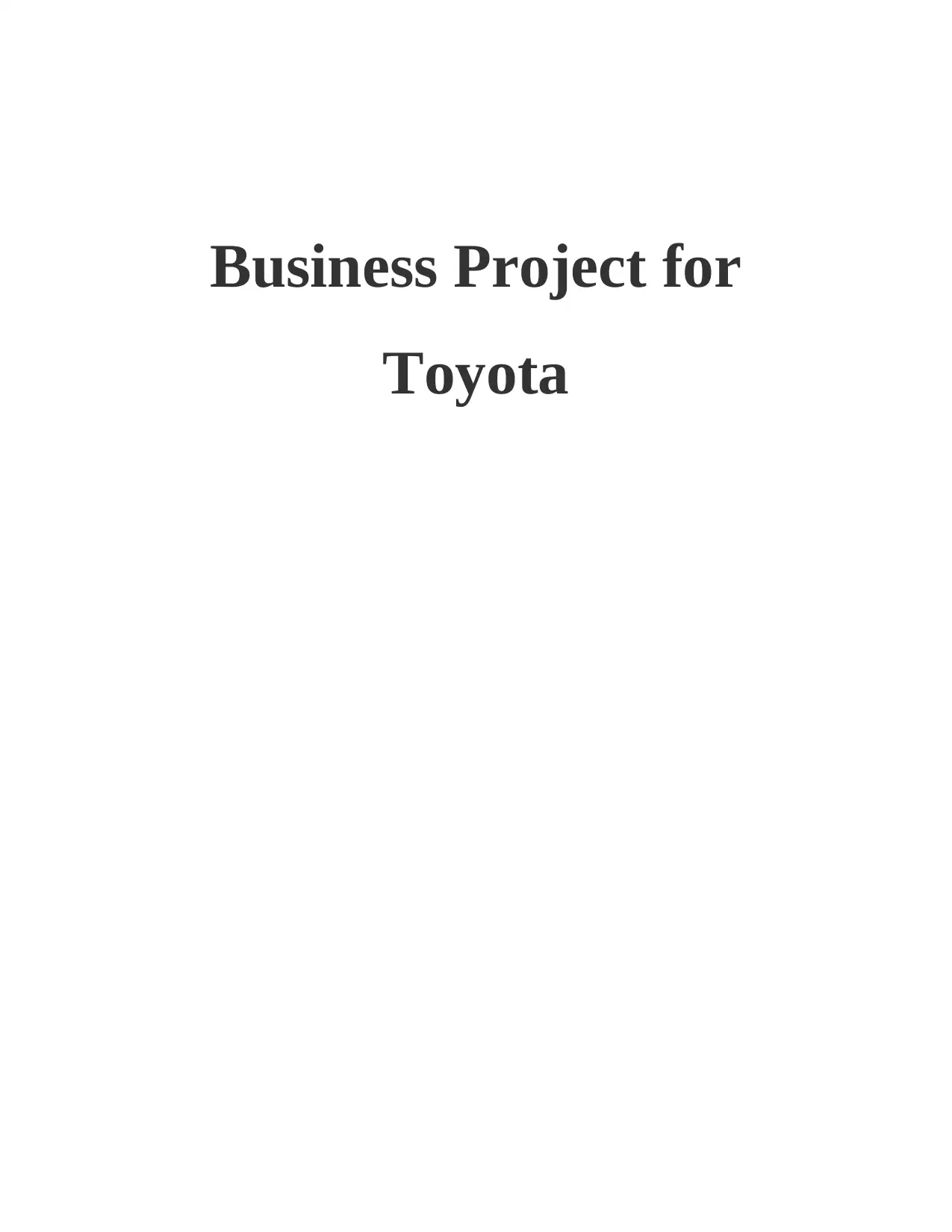
Business Project for
Toyota
Toyota
Secure Best Marks with AI Grader
Need help grading? Try our AI Grader for instant feedback on your assignments.
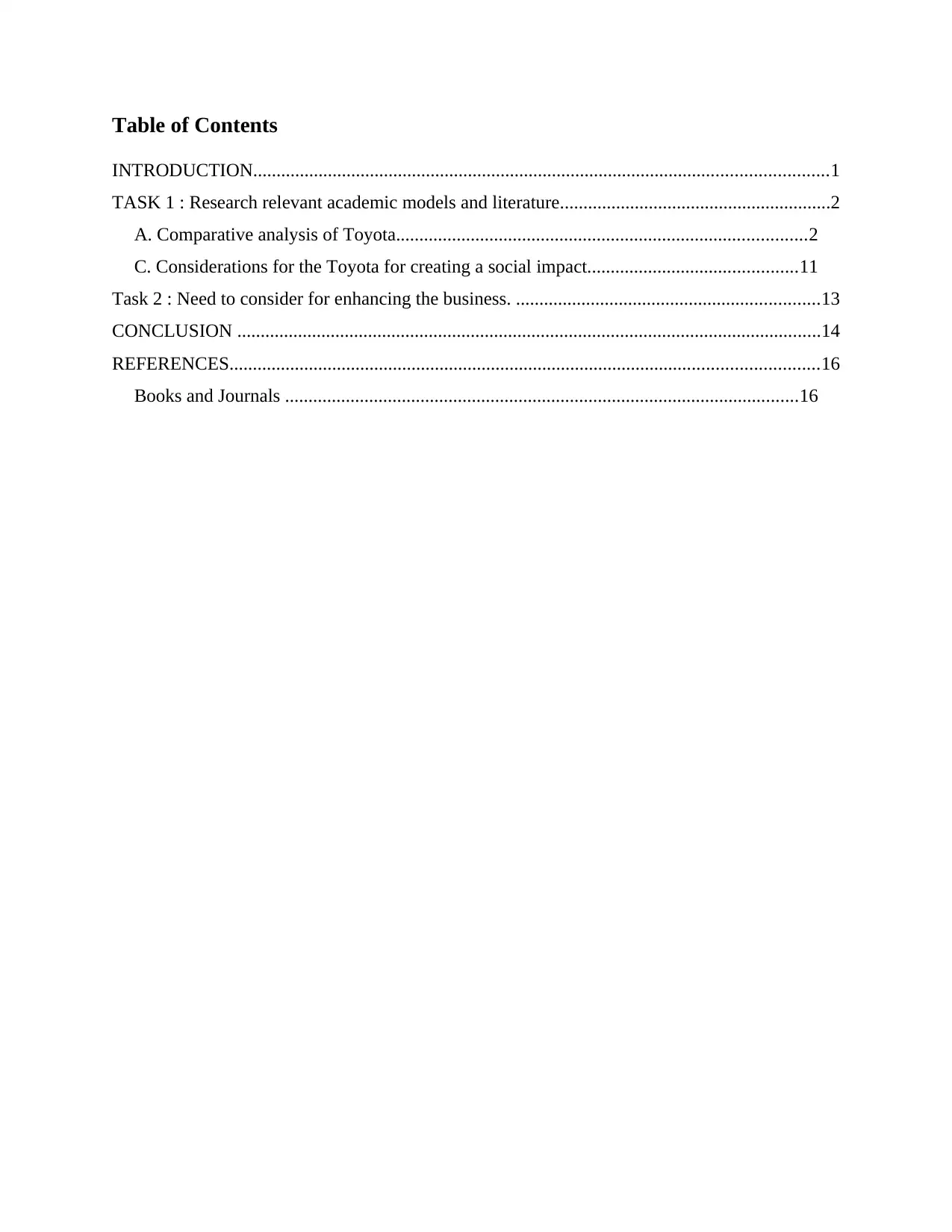
Table of Contents
INTRODUCTION...........................................................................................................................1
TASK 1 : Research relevant academic models and literature..........................................................2
A. Comparative analysis of Toyota........................................................................................2
C. Considerations for the Toyota for creating a social impact.............................................11
Task 2 : Need to consider for enhancing the business. .................................................................13
CONCLUSION .............................................................................................................................14
REFERENCES..............................................................................................................................16
Books and Journals ..............................................................................................................16
INTRODUCTION...........................................................................................................................1
TASK 1 : Research relevant academic models and literature..........................................................2
A. Comparative analysis of Toyota........................................................................................2
C. Considerations for the Toyota for creating a social impact.............................................11
Task 2 : Need to consider for enhancing the business. .................................................................13
CONCLUSION .............................................................................................................................14
REFERENCES..............................................................................................................................16
Books and Journals ..............................................................................................................16
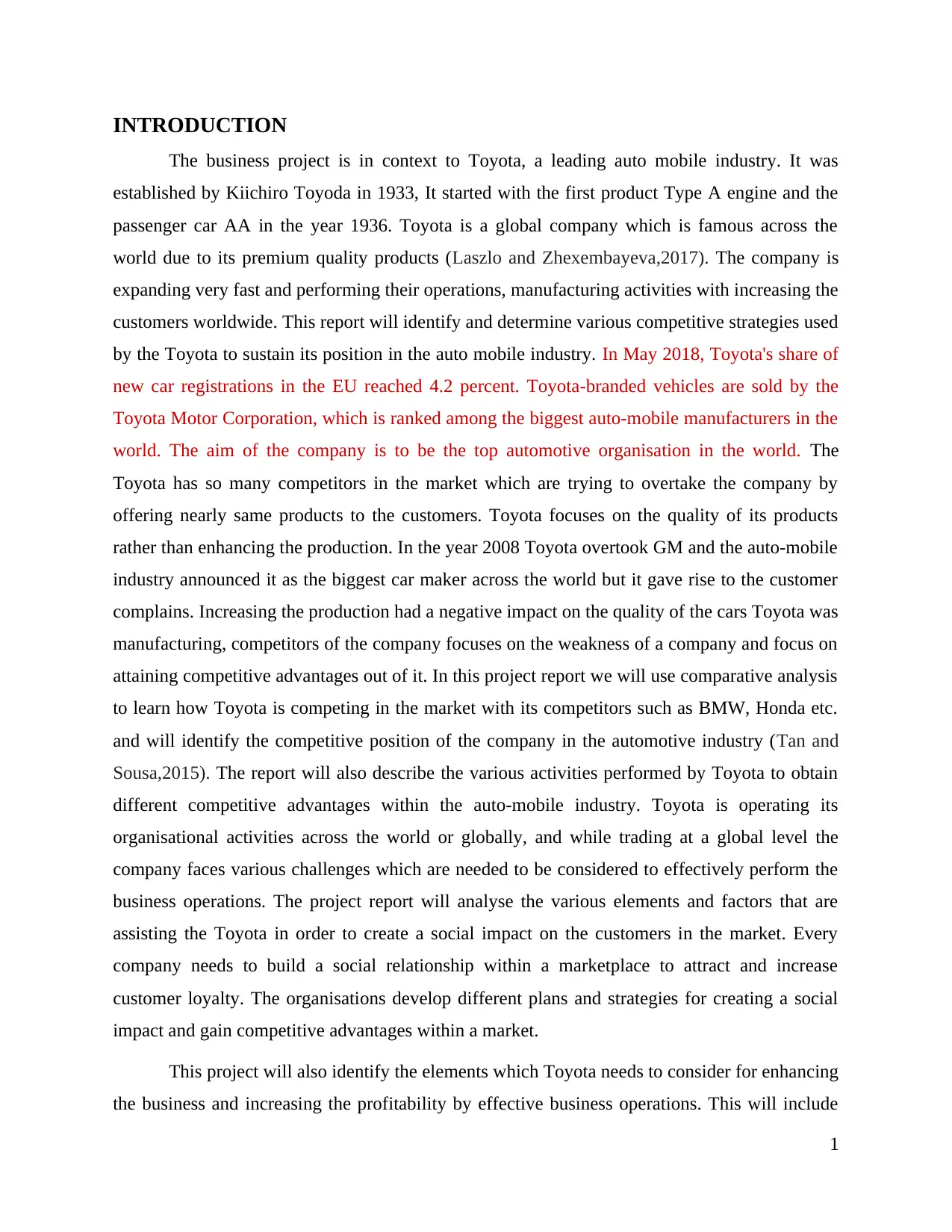
INTRODUCTION
The business project is in context to Toyota, a leading auto mobile industry. It was
established by Kiichiro Toyoda in 1933, It started with the first product Type A engine and the
passenger car AA in the year 1936. Toyota is a global company which is famous across the
world due to its premium quality products (Laszlo and Zhexembayeva,2017). The company is
expanding very fast and performing their operations, manufacturing activities with increasing the
customers worldwide. This report will identify and determine various competitive strategies used
by the Toyota to sustain its position in the auto mobile industry. In May 2018, Toyota's share of
new car registrations in the EU reached 4.2 percent. Toyota-branded vehicles are sold by the
Toyota Motor Corporation, which is ranked among the biggest auto-mobile manufacturers in the
world. The aim of the company is to be the top automotive organisation in the world. The
Toyota has so many competitors in the market which are trying to overtake the company by
offering nearly same products to the customers. Toyota focuses on the quality of its products
rather than enhancing the production. In the year 2008 Toyota overtook GM and the auto-mobile
industry announced it as the biggest car maker across the world but it gave rise to the customer
complains. Increasing the production had a negative impact on the quality of the cars Toyota was
manufacturing, competitors of the company focuses on the weakness of a company and focus on
attaining competitive advantages out of it. In this project report we will use comparative analysis
to learn how Toyota is competing in the market with its competitors such as BMW, Honda etc.
and will identify the competitive position of the company in the automotive industry (Tan and
Sousa,2015). The report will also describe the various activities performed by Toyota to obtain
different competitive advantages within the auto-mobile industry. Toyota is operating its
organisational activities across the world or globally, and while trading at a global level the
company faces various challenges which are needed to be considered to effectively perform the
business operations. The project report will analyse the various elements and factors that are
assisting the Toyota in order to create a social impact on the customers in the market. Every
company needs to build a social relationship within a marketplace to attract and increase
customer loyalty. The organisations develop different plans and strategies for creating a social
impact and gain competitive advantages within a market.
This project will also identify the elements which Toyota needs to consider for enhancing
the business and increasing the profitability by effective business operations. This will include
1
The business project is in context to Toyota, a leading auto mobile industry. It was
established by Kiichiro Toyoda in 1933, It started with the first product Type A engine and the
passenger car AA in the year 1936. Toyota is a global company which is famous across the
world due to its premium quality products (Laszlo and Zhexembayeva,2017). The company is
expanding very fast and performing their operations, manufacturing activities with increasing the
customers worldwide. This report will identify and determine various competitive strategies used
by the Toyota to sustain its position in the auto mobile industry. In May 2018, Toyota's share of
new car registrations in the EU reached 4.2 percent. Toyota-branded vehicles are sold by the
Toyota Motor Corporation, which is ranked among the biggest auto-mobile manufacturers in the
world. The aim of the company is to be the top automotive organisation in the world. The
Toyota has so many competitors in the market which are trying to overtake the company by
offering nearly same products to the customers. Toyota focuses on the quality of its products
rather than enhancing the production. In the year 2008 Toyota overtook GM and the auto-mobile
industry announced it as the biggest car maker across the world but it gave rise to the customer
complains. Increasing the production had a negative impact on the quality of the cars Toyota was
manufacturing, competitors of the company focuses on the weakness of a company and focus on
attaining competitive advantages out of it. In this project report we will use comparative analysis
to learn how Toyota is competing in the market with its competitors such as BMW, Honda etc.
and will identify the competitive position of the company in the automotive industry (Tan and
Sousa,2015). The report will also describe the various activities performed by Toyota to obtain
different competitive advantages within the auto-mobile industry. Toyota is operating its
organisational activities across the world or globally, and while trading at a global level the
company faces various challenges which are needed to be considered to effectively perform the
business operations. The project report will analyse the various elements and factors that are
assisting the Toyota in order to create a social impact on the customers in the market. Every
company needs to build a social relationship within a marketplace to attract and increase
customer loyalty. The organisations develop different plans and strategies for creating a social
impact and gain competitive advantages within a market.
This project will also identify the elements which Toyota needs to consider for enhancing
the business and increasing the profitability by effective business operations. This will include
1
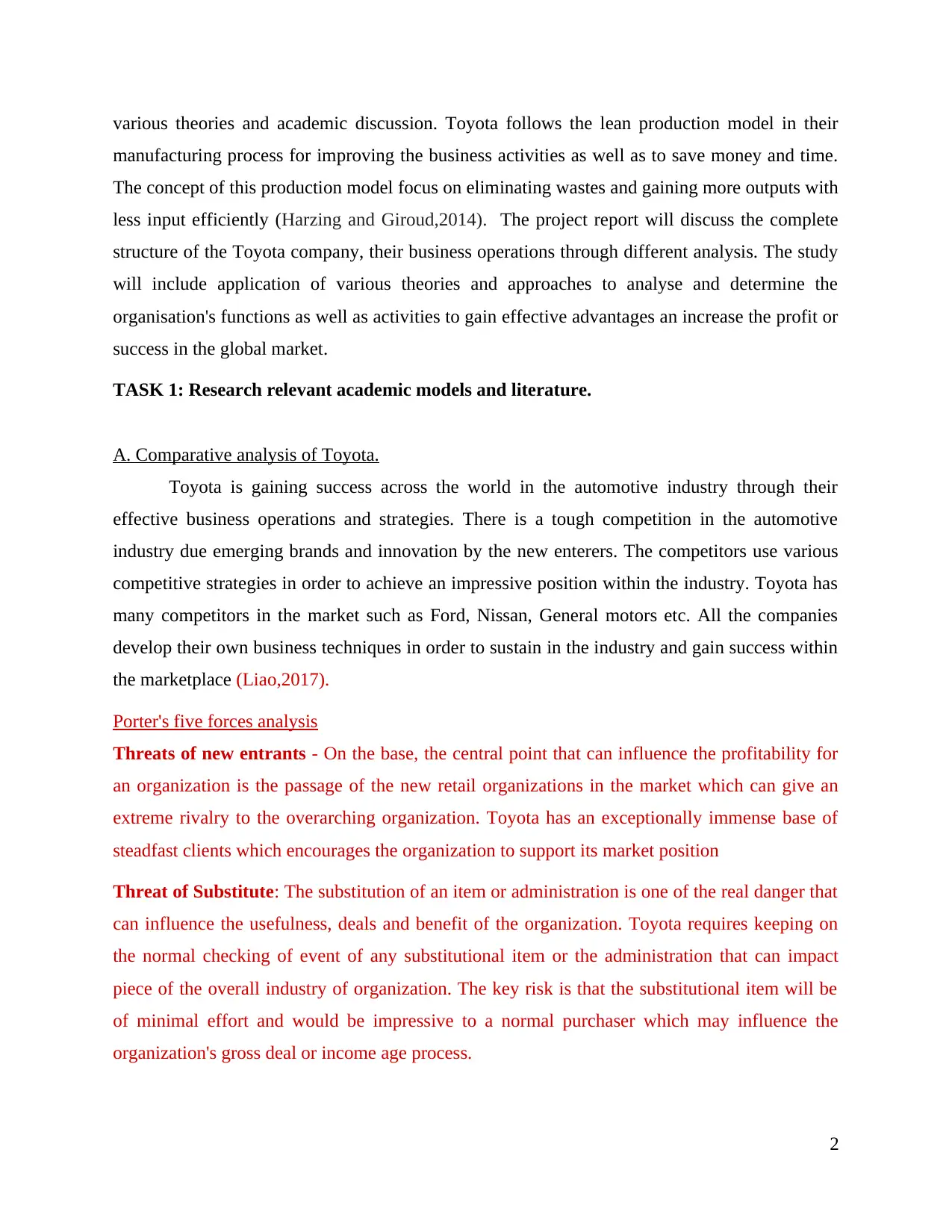
various theories and academic discussion. Toyota follows the lean production model in their
manufacturing process for improving the business activities as well as to save money and time.
The concept of this production model focus on eliminating wastes and gaining more outputs with
less input efficiently (Harzing and Giroud,2014). The project report will discuss the complete
structure of the Toyota company, their business operations through different analysis. The study
will include application of various theories and approaches to analyse and determine the
organisation's functions as well as activities to gain effective advantages an increase the profit or
success in the global market.
TASK 1: Research relevant academic models and literature.
A. Comparative analysis of Toyota.
Toyota is gaining success across the world in the automotive industry through their
effective business operations and strategies. There is a tough competition in the automotive
industry due emerging brands and innovation by the new enterers. The competitors use various
competitive strategies in order to achieve an impressive position within the industry. Toyota has
many competitors in the market such as Ford, Nissan, General motors etc. All the companies
develop their own business techniques in order to sustain in the industry and gain success within
the marketplace (Liao,2017).
Porter's five forces analysis
Threats of new entrants - On the base, the central point that can influence the profitability for
an organization is the passage of the new retail organizations in the market which can give an
extreme rivalry to the overarching organization. Toyota has an exceptionally immense base of
steadfast clients which encourages the organization to support its market position
Threat of Substitute: The substitution of an item or administration is one of the real danger that
can influence the usefulness, deals and benefit of the organization. Toyota requires keeping on
the normal checking of event of any substitutional item or the administration that can impact
piece of the overall industry of organization. The key risk is that the substitutional item will be
of minimal effort and would be impressive to a normal purchaser which may influence the
organization's gross deal or income age process.
2
manufacturing process for improving the business activities as well as to save money and time.
The concept of this production model focus on eliminating wastes and gaining more outputs with
less input efficiently (Harzing and Giroud,2014). The project report will discuss the complete
structure of the Toyota company, their business operations through different analysis. The study
will include application of various theories and approaches to analyse and determine the
organisation's functions as well as activities to gain effective advantages an increase the profit or
success in the global market.
TASK 1: Research relevant academic models and literature.
A. Comparative analysis of Toyota.
Toyota is gaining success across the world in the automotive industry through their
effective business operations and strategies. There is a tough competition in the automotive
industry due emerging brands and innovation by the new enterers. The competitors use various
competitive strategies in order to achieve an impressive position within the industry. Toyota has
many competitors in the market such as Ford, Nissan, General motors etc. All the companies
develop their own business techniques in order to sustain in the industry and gain success within
the marketplace (Liao,2017).
Porter's five forces analysis
Threats of new entrants - On the base, the central point that can influence the profitability for
an organization is the passage of the new retail organizations in the market which can give an
extreme rivalry to the overarching organization. Toyota has an exceptionally immense base of
steadfast clients which encourages the organization to support its market position
Threat of Substitute: The substitution of an item or administration is one of the real danger that
can influence the usefulness, deals and benefit of the organization. Toyota requires keeping on
the normal checking of event of any substitutional item or the administration that can impact
piece of the overall industry of organization. The key risk is that the substitutional item will be
of minimal effort and would be impressive to a normal purchaser which may influence the
organization's gross deal or income age process.
2
Paraphrase This Document
Need a fresh take? Get an instant paraphrase of this document with our AI Paraphraser
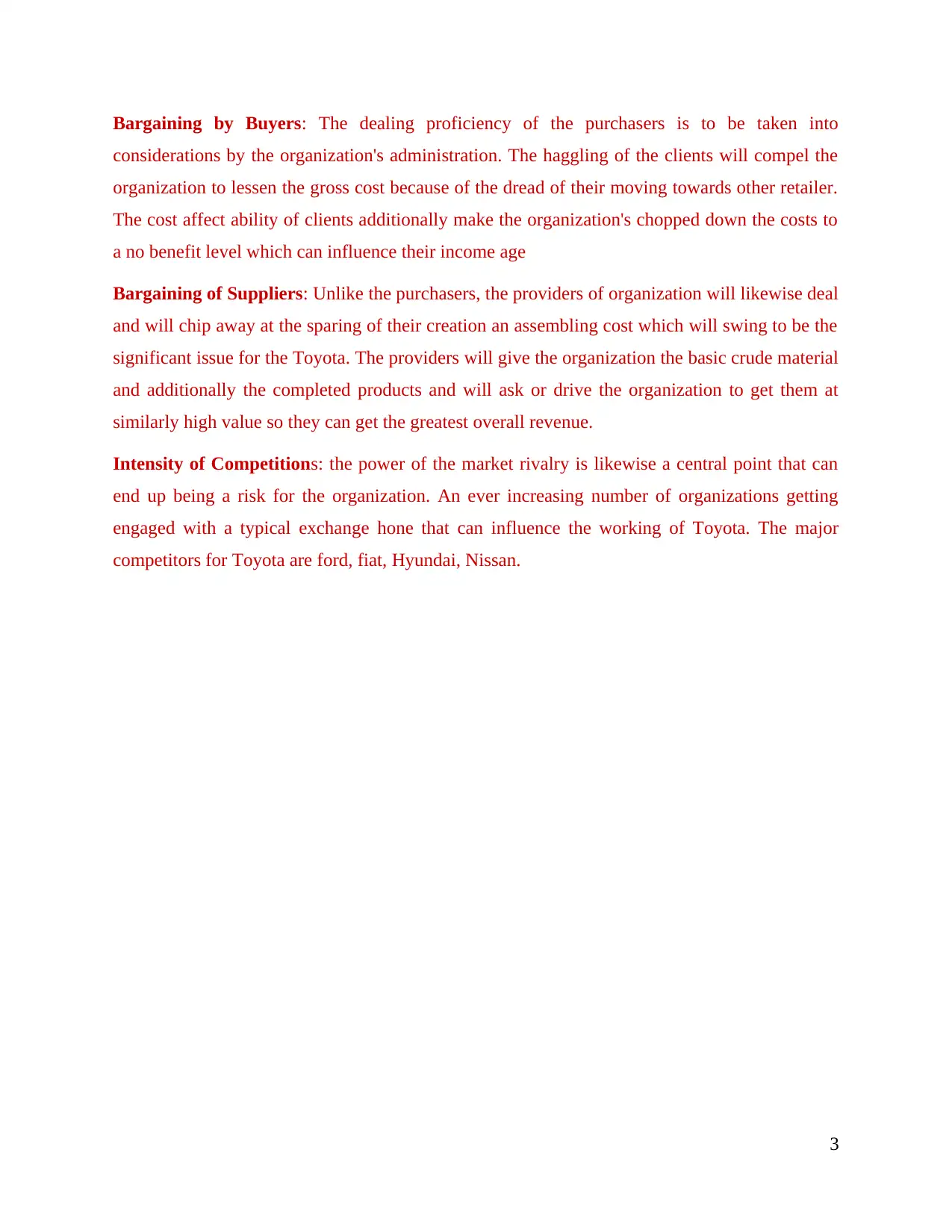
Bargaining by Buyers: The dealing proficiency of the purchasers is to be taken into
considerations by the organization's administration. The haggling of the clients will compel the
organization to lessen the gross cost because of the dread of their moving towards other retailer.
The cost affect ability of clients additionally make the organization's chopped down the costs to
a no benefit level which can influence their income age
Bargaining of Suppliers: Unlike the purchasers, the providers of organization will likewise deal
and will chip away at the sparing of their creation an assembling cost which will swing to be the
significant issue for the Toyota. The providers will give the organization the basic crude material
and additionally the completed products and will ask or drive the organization to get them at
similarly high value so they can get the greatest overall revenue.
Intensity of Competitions: the power of the market rivalry is likewise a central point that can
end up being a risk for the organization. An ever increasing number of organizations getting
engaged with a typical exchange hone that can influence the working of Toyota. The major
competitors for Toyota are ford, fiat, Hyundai, Nissan.
3
considerations by the organization's administration. The haggling of the clients will compel the
organization to lessen the gross cost because of the dread of their moving towards other retailer.
The cost affect ability of clients additionally make the organization's chopped down the costs to
a no benefit level which can influence their income age
Bargaining of Suppliers: Unlike the purchasers, the providers of organization will likewise deal
and will chip away at the sparing of their creation an assembling cost which will swing to be the
significant issue for the Toyota. The providers will give the organization the basic crude material
and additionally the completed products and will ask or drive the organization to get them at
similarly high value so they can get the greatest overall revenue.
Intensity of Competitions: the power of the market rivalry is likewise a central point that can
end up being a risk for the organization. An ever increasing number of organizations getting
engaged with a typical exchange hone that can influence the working of Toyota. The major
competitors for Toyota are ford, fiat, Hyundai, Nissan.
3

Illustration 1: comparative analysis
Gross Profit Margin – As per the above graph the Toyota is leading its competitors in terms of
gross profit margin. The Toyota's profit margin is impressive as compared to the other
companies in the auto-mobile industry such as General motors and Volkswagen. The Toyota
has 19.5% of gross profit margin whereas GM and Volkswagen have 17.2% and 17.11%.
The Gross profit margin refers to the gross earnings of an organisation after deducting the
selling and production expenses from the total income. This analysis clearly states that
Toyota is effectively managing its cost and income in order to hold a leading position in the
market.
Operating Profit Margin – The Toyota's Operating profit margin or the proportion of the
company's revenue over the variable cost is 2.47% as per the graph mentioned above. The
General motor has 8.7% and 11.4%. In terms of Operating profit margin Toyota is lacking
and needs to work on in order to overtake its competitors (Nazarpour and et.al,2014).
4
Gross Profit Margin – As per the above graph the Toyota is leading its competitors in terms of
gross profit margin. The Toyota's profit margin is impressive as compared to the other
companies in the auto-mobile industry such as General motors and Volkswagen. The Toyota
has 19.5% of gross profit margin whereas GM and Volkswagen have 17.2% and 17.11%.
The Gross profit margin refers to the gross earnings of an organisation after deducting the
selling and production expenses from the total income. This analysis clearly states that
Toyota is effectively managing its cost and income in order to hold a leading position in the
market.
Operating Profit Margin – The Toyota's Operating profit margin or the proportion of the
company's revenue over the variable cost is 2.47% as per the graph mentioned above. The
General motor has 8.7% and 11.4%. In terms of Operating profit margin Toyota is lacking
and needs to work on in order to overtake its competitors (Nazarpour and et.al,2014).
4

Net profit margin – The Toyota has 2.15% of net profit margin which comparatively very low as
compared to General motors and Volkswagen which are 7.2% and 10.7%. This states that
Toyota is not gaining much profit over its expenses. It can be threat for the company as
competitors are leaving it more behind.
Return on Equity – Toyota obtain 3.95% of return on Equity, comparison to this General motors
and Volkswagen attain 28.7% and 32.10% which is relatively more and affecting the
position of the Toyota in the automotive industry.
Return on Assets – The General motors and Volkswagen gain 6.6% and 3.08% of return on
assets as per the above graph which is again more than Toyota's 1.37% of return on Assets.
The above graph and interpretation proves that the Toyota's gross profit margin is leading as
compared to the competitors, General motor and Volkswagen. But the other statistics are not in
favour of the company as the competitors are far better than Toyota.
The above illustration shows that the Toyota stands at 7th position as compared to the
competitors in the automotive industry. The Competitors such as Hyundai, Ford and
5
Illustration 2: Comparative Ranking
compared to General motors and Volkswagen which are 7.2% and 10.7%. This states that
Toyota is not gaining much profit over its expenses. It can be threat for the company as
competitors are leaving it more behind.
Return on Equity – Toyota obtain 3.95% of return on Equity, comparison to this General motors
and Volkswagen attain 28.7% and 32.10% which is relatively more and affecting the
position of the Toyota in the automotive industry.
Return on Assets – The General motors and Volkswagen gain 6.6% and 3.08% of return on
assets as per the above graph which is again more than Toyota's 1.37% of return on Assets.
The above graph and interpretation proves that the Toyota's gross profit margin is leading as
compared to the competitors, General motor and Volkswagen. But the other statistics are not in
favour of the company as the competitors are far better than Toyota.
The above illustration shows that the Toyota stands at 7th position as compared to the
competitors in the automotive industry. The Competitors such as Hyundai, Ford and
5
Illustration 2: Comparative Ranking
Secure Best Marks with AI Grader
Need help grading? Try our AI Grader for instant feedback on your assignments.
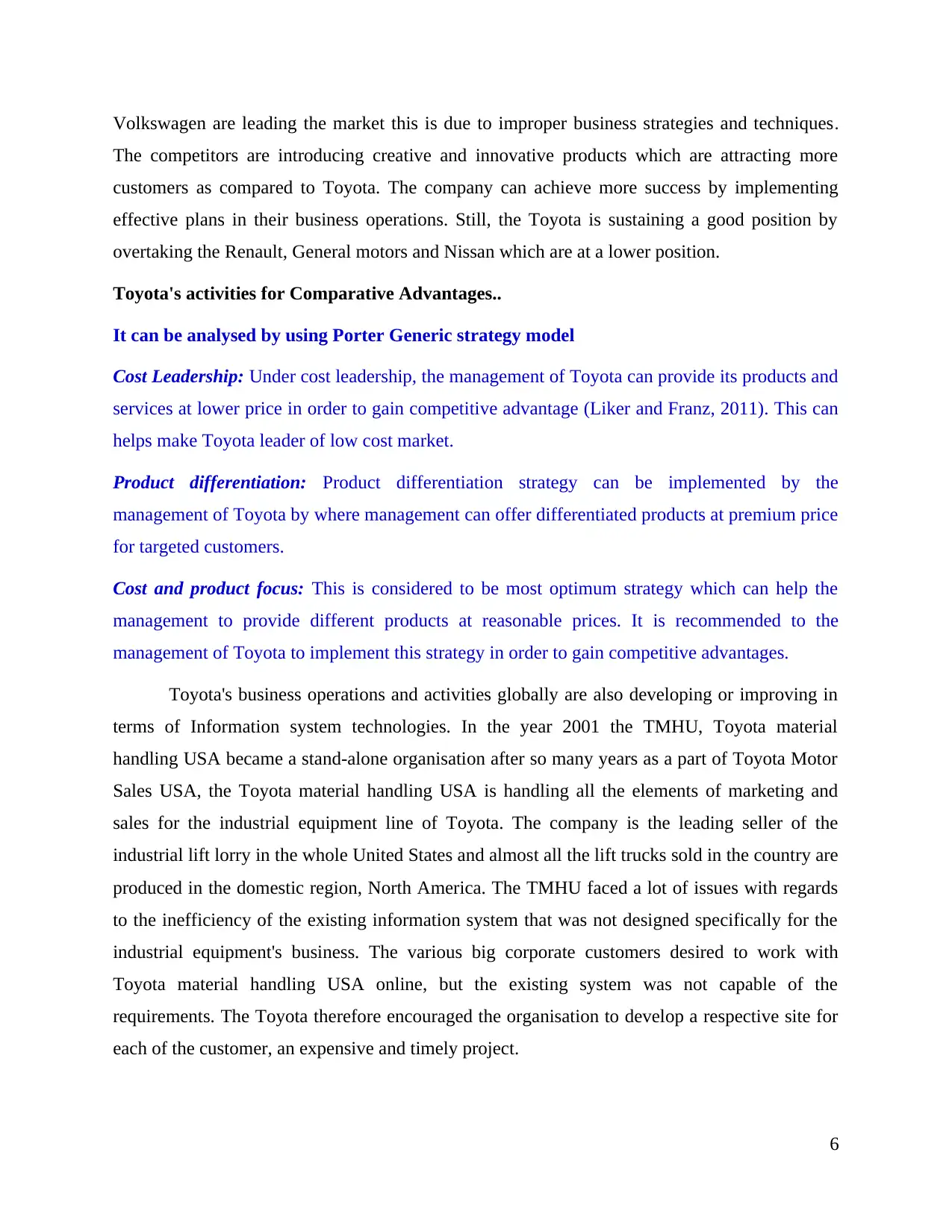
Volkswagen are leading the market this is due to improper business strategies and techniques.
The competitors are introducing creative and innovative products which are attracting more
customers as compared to Toyota. The company can achieve more success by implementing
effective plans in their business operations. Still, the Toyota is sustaining a good position by
overtaking the Renault, General motors and Nissan which are at a lower position.
Toyota's activities for Comparative Advantages..
It can be analysed by using Porter Generic strategy model
Cost Leadership: Under cost leadership, the management of Toyota can provide its products and
services at lower price in order to gain competitive advantage (Liker and Franz, 2011). This can
helps make Toyota leader of low cost market.
Product differentiation: Product differentiation strategy can be implemented by the
management of Toyota by where management can offer differentiated products at premium price
for targeted customers.
Cost and product focus: This is considered to be most optimum strategy which can help the
management to provide different products at reasonable prices. It is recommended to the
management of Toyota to implement this strategy in order to gain competitive advantages.
Toyota's business operations and activities globally are also developing or improving in
terms of Information system technologies. In the year 2001 the TMHU, Toyota material
handling USA became a stand-alone organisation after so many years as a part of Toyota Motor
Sales USA, the Toyota material handling USA is handling all the elements of marketing and
sales for the industrial equipment line of Toyota. The company is the leading seller of the
industrial lift lorry in the whole United States and almost all the lift trucks sold in the country are
produced in the domestic region, North America. The TMHU faced a lot of issues with regards
to the inefficiency of the existing information system that was not designed specifically for the
industrial equipment's business. The various big corporate customers desired to work with
Toyota material handling USA online, but the existing system was not capable of the
requirements. The Toyota therefore encouraged the organisation to develop a respective site for
each of the customer, an expensive and timely project.
6
The competitors are introducing creative and innovative products which are attracting more
customers as compared to Toyota. The company can achieve more success by implementing
effective plans in their business operations. Still, the Toyota is sustaining a good position by
overtaking the Renault, General motors and Nissan which are at a lower position.
Toyota's activities for Comparative Advantages..
It can be analysed by using Porter Generic strategy model
Cost Leadership: Under cost leadership, the management of Toyota can provide its products and
services at lower price in order to gain competitive advantage (Liker and Franz, 2011). This can
helps make Toyota leader of low cost market.
Product differentiation: Product differentiation strategy can be implemented by the
management of Toyota by where management can offer differentiated products at premium price
for targeted customers.
Cost and product focus: This is considered to be most optimum strategy which can help the
management to provide different products at reasonable prices. It is recommended to the
management of Toyota to implement this strategy in order to gain competitive advantages.
Toyota's business operations and activities globally are also developing or improving in
terms of Information system technologies. In the year 2001 the TMHU, Toyota material
handling USA became a stand-alone organisation after so many years as a part of Toyota Motor
Sales USA, the Toyota material handling USA is handling all the elements of marketing and
sales for the industrial equipment line of Toyota. The company is the leading seller of the
industrial lift lorry in the whole United States and almost all the lift trucks sold in the country are
produced in the domestic region, North America. The TMHU faced a lot of issues with regards
to the inefficiency of the existing information system that was not designed specifically for the
industrial equipment's business. The various big corporate customers desired to work with
Toyota material handling USA online, but the existing system was not capable of the
requirements. The Toyota therefore encouraged the organisation to develop a respective site for
each of the customer, an expensive and timely project.
6
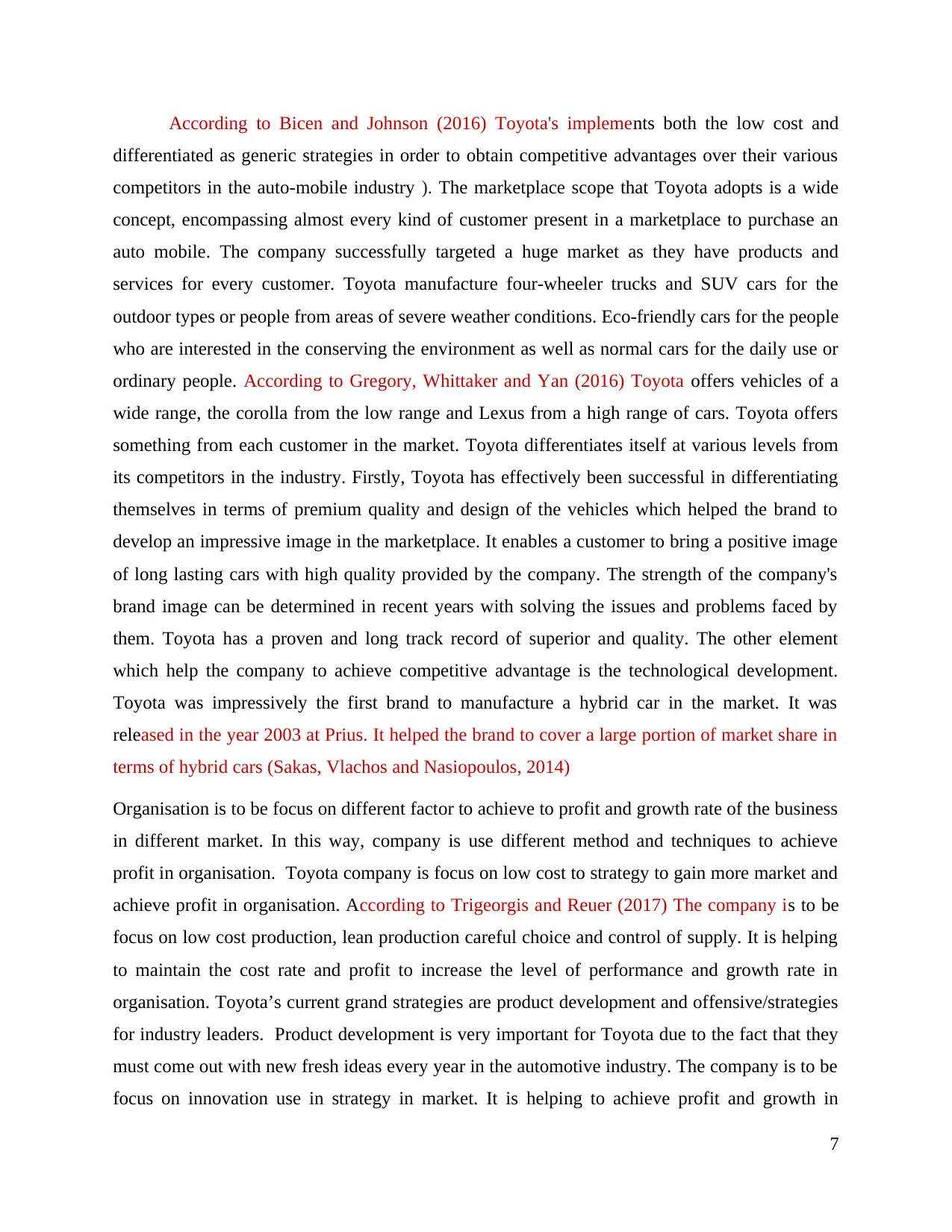
According to Bicen and Johnson (2016) Toyota's implements both the low cost and
differentiated as generic strategies in order to obtain competitive advantages over their various
competitors in the auto-mobile industry ). The marketplace scope that Toyota adopts is a wide
concept, encompassing almost every kind of customer present in a marketplace to purchase an
auto mobile. The company successfully targeted a huge market as they have products and
services for every customer. Toyota manufacture four-wheeler trucks and SUV cars for the
outdoor types or people from areas of severe weather conditions. Eco-friendly cars for the people
who are interested in the conserving the environment as well as normal cars for the daily use or
ordinary people. According to Gregory, Whittaker and Yan (2016) Toyota offers vehicles of a
wide range, the corolla from the low range and Lexus from a high range of cars. Toyota offers
something from each customer in the market. Toyota differentiates itself at various levels from
its competitors in the industry. Firstly, Toyota has effectively been successful in differentiating
themselves in terms of premium quality and design of the vehicles which helped the brand to
develop an impressive image in the marketplace. It enables a customer to bring a positive image
of long lasting cars with high quality provided by the company. The strength of the company's
brand image can be determined in recent years with solving the issues and problems faced by
them. Toyota has a proven and long track record of superior and quality. The other element
which help the company to achieve competitive advantage is the technological development.
Toyota was impressively the first brand to manufacture a hybrid car in the market. It was
released in the year 2003 at Prius. It helped the brand to cover a large portion of market share in
terms of hybrid cars (Sakas, Vlachos and Nasiopoulos, 2014)
Organisation is to be focus on different factor to achieve to profit and growth rate of the business
in different market. In this way, company is use different method and techniques to achieve
profit in organisation. Toyota company is focus on low cost to strategy to gain more market and
achieve profit in organisation. According to Trigeorgis and Reuer (2017) The company is to be
focus on low cost production, lean production careful choice and control of supply. It is helping
to maintain the cost rate and profit to increase the level of performance and growth rate in
organisation. Toyota’s current grand strategies are product development and offensive/strategies
for industry leaders. Product development is very important for Toyota due to the fact that they
must come out with new fresh ideas every year in the automotive industry. The company is to be
focus on innovation use in strategy in market. It is helping to achieve profit and growth in
7
differentiated as generic strategies in order to obtain competitive advantages over their various
competitors in the auto-mobile industry ). The marketplace scope that Toyota adopts is a wide
concept, encompassing almost every kind of customer present in a marketplace to purchase an
auto mobile. The company successfully targeted a huge market as they have products and
services for every customer. Toyota manufacture four-wheeler trucks and SUV cars for the
outdoor types or people from areas of severe weather conditions. Eco-friendly cars for the people
who are interested in the conserving the environment as well as normal cars for the daily use or
ordinary people. According to Gregory, Whittaker and Yan (2016) Toyota offers vehicles of a
wide range, the corolla from the low range and Lexus from a high range of cars. Toyota offers
something from each customer in the market. Toyota differentiates itself at various levels from
its competitors in the industry. Firstly, Toyota has effectively been successful in differentiating
themselves in terms of premium quality and design of the vehicles which helped the brand to
develop an impressive image in the marketplace. It enables a customer to bring a positive image
of long lasting cars with high quality provided by the company. The strength of the company's
brand image can be determined in recent years with solving the issues and problems faced by
them. Toyota has a proven and long track record of superior and quality. The other element
which help the company to achieve competitive advantage is the technological development.
Toyota was impressively the first brand to manufacture a hybrid car in the market. It was
released in the year 2003 at Prius. It helped the brand to cover a large portion of market share in
terms of hybrid cars (Sakas, Vlachos and Nasiopoulos, 2014)
Organisation is to be focus on different factor to achieve to profit and growth rate of the business
in different market. In this way, company is use different method and techniques to achieve
profit in organisation. Toyota company is focus on low cost to strategy to gain more market and
achieve profit in organisation. According to Trigeorgis and Reuer (2017) The company is to be
focus on low cost production, lean production careful choice and control of supply. It is helping
to maintain the cost rate and profit to increase the level of performance and growth rate in
organisation. Toyota’s current grand strategies are product development and offensive/strategies
for industry leaders. Product development is very important for Toyota due to the fact that they
must come out with new fresh ideas every year in the automotive industry. The company is to be
focus on innovation use in strategy in market. It is helping to achieve profit and growth in
7
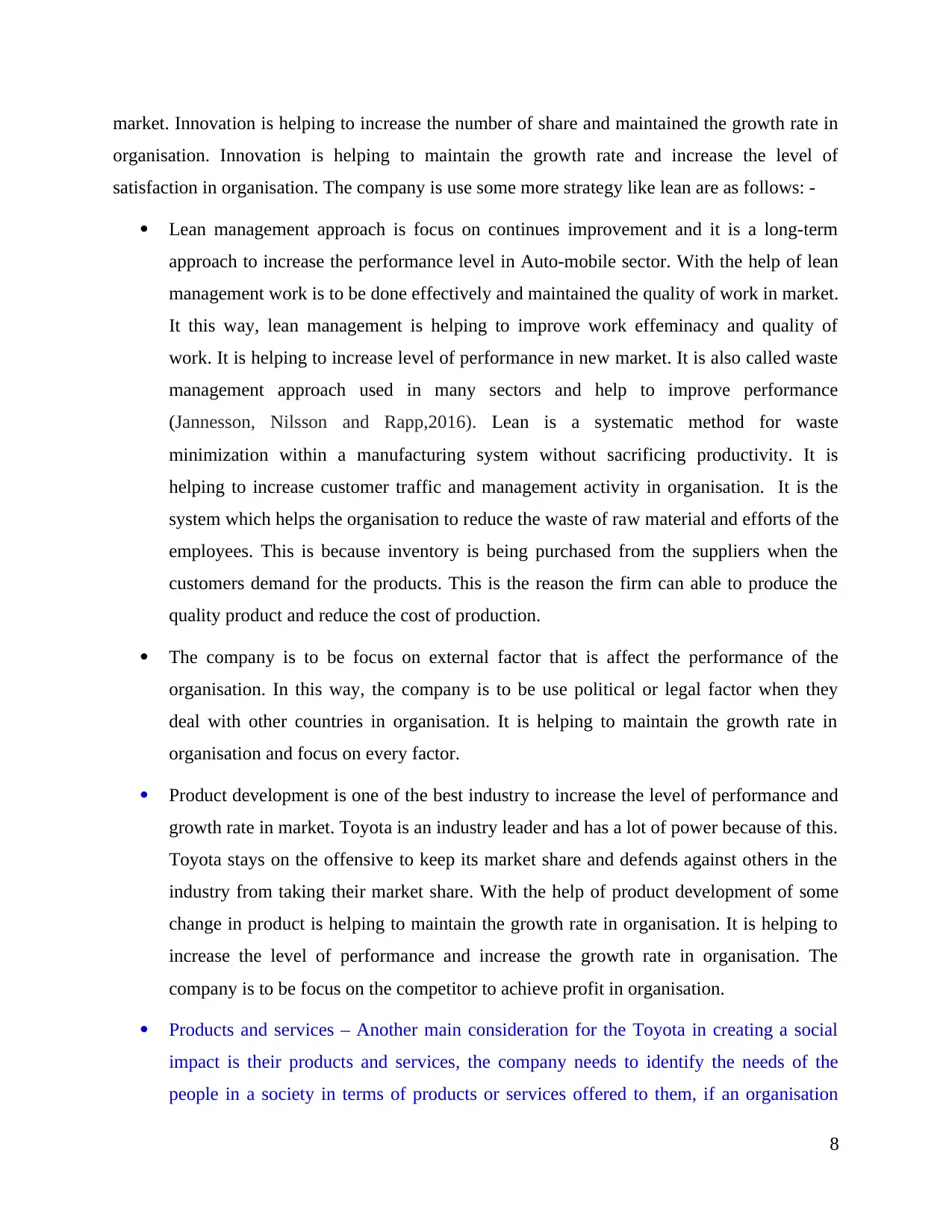
market. Innovation is helping to increase the number of share and maintained the growth rate in
organisation. Innovation is helping to maintain the growth rate and increase the level of
satisfaction in organisation. The company is use some more strategy like lean are as follows: -
Lean management approach is focus on continues improvement and it is a long-term
approach to increase the performance level in Auto-mobile sector. With the help of lean
management work is to be done effectively and maintained the quality of work in market.
It this way, lean management is helping to improve work effeminacy and quality of
work. It is helping to increase level of performance in new market. It is also called waste
management approach used in many sectors and help to improve performance
(Jannesson, Nilsson and Rapp,2016). Lean is a systematic method for waste
minimization within a manufacturing system without sacrificing productivity. It is
helping to increase customer traffic and management activity in organisation. It is the
system which helps the organisation to reduce the waste of raw material and efforts of the
employees. This is because inventory is being purchased from the suppliers when the
customers demand for the products. This is the reason the firm can able to produce the
quality product and reduce the cost of production.
The company is to be focus on external factor that is affect the performance of the
organisation. In this way, the company is to be use political or legal factor when they
deal with other countries in organisation. It is helping to maintain the growth rate in
organisation and focus on every factor.
Product development is one of the best industry to increase the level of performance and
growth rate in market. Toyota is an industry leader and has a lot of power because of this.
Toyota stays on the offensive to keep its market share and defends against others in the
industry from taking their market share. With the help of product development of some
change in product is helping to maintain the growth rate in organisation. It is helping to
increase the level of performance and increase the growth rate in organisation. The
company is to be focus on the competitor to achieve profit in organisation.
Products and services – Another main consideration for the Toyota in creating a social
impact is their products and services, the company needs to identify the needs of the
people in a society in terms of products or services offered to them, if an organisation
8
organisation. Innovation is helping to maintain the growth rate and increase the level of
satisfaction in organisation. The company is use some more strategy like lean are as follows: -
Lean management approach is focus on continues improvement and it is a long-term
approach to increase the performance level in Auto-mobile sector. With the help of lean
management work is to be done effectively and maintained the quality of work in market.
It this way, lean management is helping to improve work effeminacy and quality of
work. It is helping to increase level of performance in new market. It is also called waste
management approach used in many sectors and help to improve performance
(Jannesson, Nilsson and Rapp,2016). Lean is a systematic method for waste
minimization within a manufacturing system without sacrificing productivity. It is
helping to increase customer traffic and management activity in organisation. It is the
system which helps the organisation to reduce the waste of raw material and efforts of the
employees. This is because inventory is being purchased from the suppliers when the
customers demand for the products. This is the reason the firm can able to produce the
quality product and reduce the cost of production.
The company is to be focus on external factor that is affect the performance of the
organisation. In this way, the company is to be use political or legal factor when they
deal with other countries in organisation. It is helping to maintain the growth rate in
organisation and focus on every factor.
Product development is one of the best industry to increase the level of performance and
growth rate in market. Toyota is an industry leader and has a lot of power because of this.
Toyota stays on the offensive to keep its market share and defends against others in the
industry from taking their market share. With the help of product development of some
change in product is helping to maintain the growth rate in organisation. It is helping to
increase the level of performance and increase the growth rate in organisation. The
company is to be focus on the competitor to achieve profit in organisation.
Products and services – Another main consideration for the Toyota in creating a social
impact is their products and services, the company needs to identify the needs of the
people in a society in terms of products or services offered to them, if an organisation
8
Paraphrase This Document
Need a fresh take? Get an instant paraphrase of this document with our AI Paraphraser
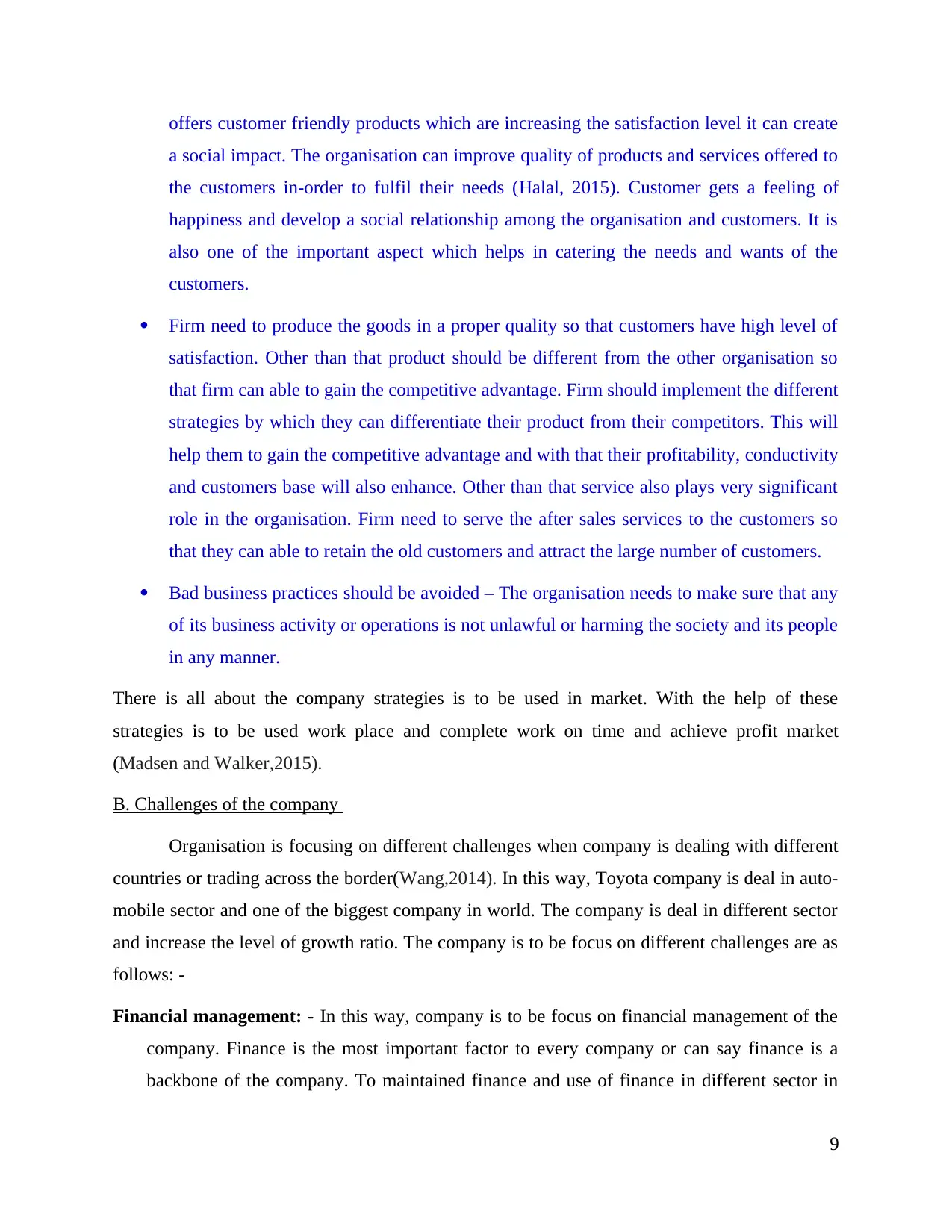
offers customer friendly products which are increasing the satisfaction level it can create
a social impact. The organisation can improve quality of products and services offered to
the customers in-order to fulfil their needs (Halal, 2015). Customer gets a feeling of
happiness and develop a social relationship among the organisation and customers. It is
also one of the important aspect which helps in catering the needs and wants of the
customers.
Firm need to produce the goods in a proper quality so that customers have high level of
satisfaction. Other than that product should be different from the other organisation so
that firm can able to gain the competitive advantage. Firm should implement the different
strategies by which they can differentiate their product from their competitors. This will
help them to gain the competitive advantage and with that their profitability, conductivity
and customers base will also enhance. Other than that service also plays very significant
role in the organisation. Firm need to serve the after sales services to the customers so
that they can able to retain the old customers and attract the large number of customers.
Bad business practices should be avoided – The organisation needs to make sure that any
of its business activity or operations is not unlawful or harming the society and its people
in any manner.
There is all about the company strategies is to be used in market. With the help of these
strategies is to be used work place and complete work on time and achieve profit market
(Madsen and Walker,2015).
B. Challenges of the company
Organisation is focusing on different challenges when company is dealing with different
countries or trading across the border(Wang,2014). In this way, Toyota company is deal in auto-
mobile sector and one of the biggest company in world. The company is deal in different sector
and increase the level of growth ratio. The company is to be focus on different challenges are as
follows: -
Financial management: - In this way, company is to be focus on financial management of the
company. Finance is the most important factor to every company or can say finance is a
backbone of the company. To maintained finance and use of finance in different sector in
9
a social impact. The organisation can improve quality of products and services offered to
the customers in-order to fulfil their needs (Halal, 2015). Customer gets a feeling of
happiness and develop a social relationship among the organisation and customers. It is
also one of the important aspect which helps in catering the needs and wants of the
customers.
Firm need to produce the goods in a proper quality so that customers have high level of
satisfaction. Other than that product should be different from the other organisation so
that firm can able to gain the competitive advantage. Firm should implement the different
strategies by which they can differentiate their product from their competitors. This will
help them to gain the competitive advantage and with that their profitability, conductivity
and customers base will also enhance. Other than that service also plays very significant
role in the organisation. Firm need to serve the after sales services to the customers so
that they can able to retain the old customers and attract the large number of customers.
Bad business practices should be avoided – The organisation needs to make sure that any
of its business activity or operations is not unlawful or harming the society and its people
in any manner.
There is all about the company strategies is to be used in market. With the help of these
strategies is to be used work place and complete work on time and achieve profit market
(Madsen and Walker,2015).
B. Challenges of the company
Organisation is focusing on different challenges when company is dealing with different
countries or trading across the border(Wang,2014). In this way, Toyota company is deal in auto-
mobile sector and one of the biggest company in world. The company is deal in different sector
and increase the level of growth ratio. The company is to be focus on different challenges are as
follows: -
Financial management: - In this way, company is to be focus on financial management of the
company. Finance is the most important factor to every company or can say finance is a
backbone of the company. To maintained finance and use of finance in different sector in
9
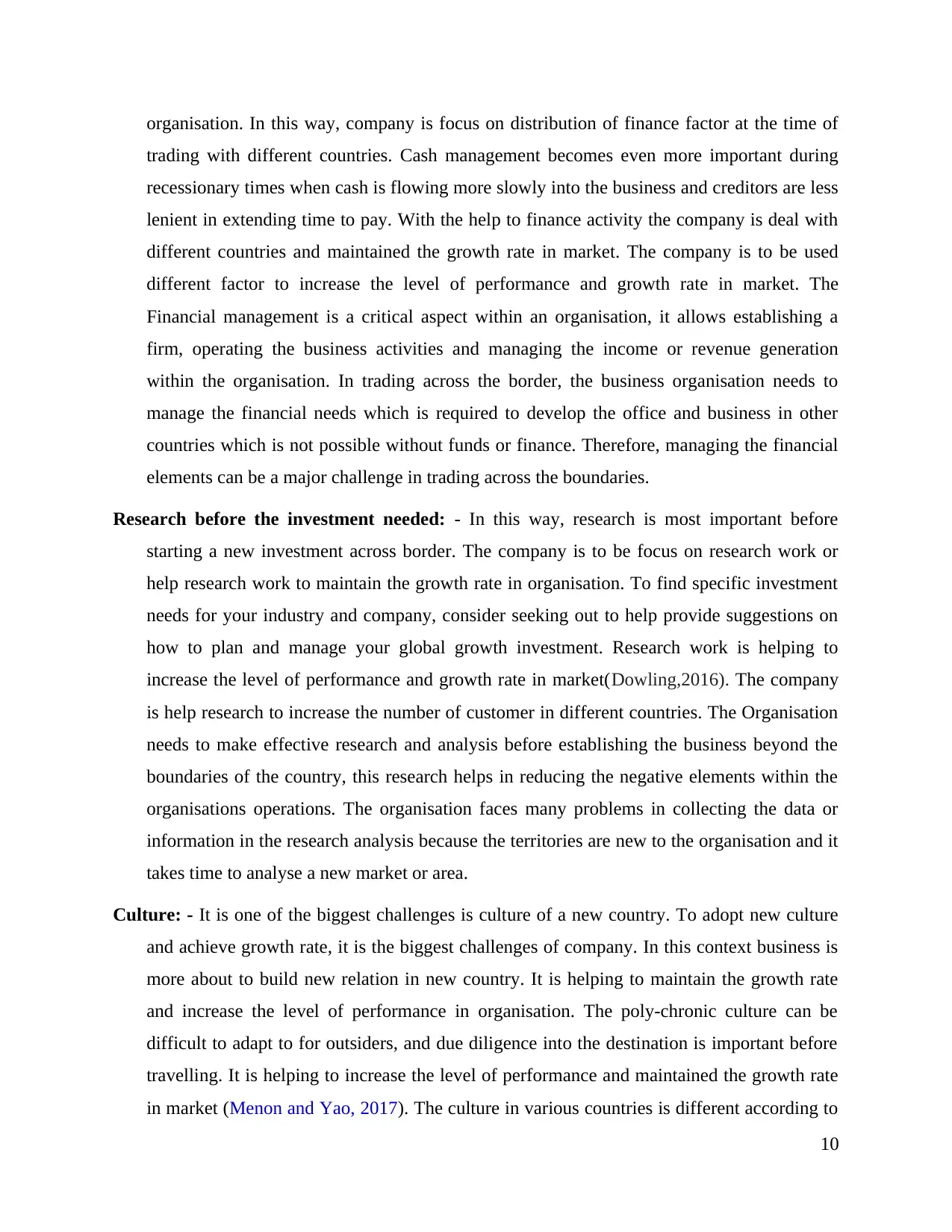
organisation. In this way, company is focus on distribution of finance factor at the time of
trading with different countries. Cash management becomes even more important during
recessionary times when cash is flowing more slowly into the business and creditors are less
lenient in extending time to pay. With the help to finance activity the company is deal with
different countries and maintained the growth rate in market. The company is to be used
different factor to increase the level of performance and growth rate in market. The
Financial management is a critical aspect within an organisation, it allows establishing a
firm, operating the business activities and managing the income or revenue generation
within the organisation. In trading across the border, the business organisation needs to
manage the financial needs which is required to develop the office and business in other
countries which is not possible without funds or finance. Therefore, managing the financial
elements can be a major challenge in trading across the boundaries.
Research before the investment needed: - In this way, research is most important before
starting a new investment across border. The company is to be focus on research work or
help research work to maintain the growth rate in organisation. To find specific investment
needs for your industry and company, consider seeking out to help provide suggestions on
how to plan and manage your global growth investment. Research work is helping to
increase the level of performance and growth rate in market(Dowling,2016). The company
is help research to increase the number of customer in different countries. The Organisation
needs to make effective research and analysis before establishing the business beyond the
boundaries of the country, this research helps in reducing the negative elements within the
organisations operations. The organisation faces many problems in collecting the data or
information in the research analysis because the territories are new to the organisation and it
takes time to analyse a new market or area.
Culture: - It is one of the biggest challenges is culture of a new country. To adopt new culture
and achieve growth rate, it is the biggest challenges of company. In this context business is
more about to build new relation in new country. It is helping to maintain the growth rate
and increase the level of performance in organisation. The poly-chronic culture can be
difficult to adapt to for outsiders, and due diligence into the destination is important before
travelling. It is helping to increase the level of performance and maintained the growth rate
in market (Menon and Yao, 2017). The culture in various countries is different according to
10
trading with different countries. Cash management becomes even more important during
recessionary times when cash is flowing more slowly into the business and creditors are less
lenient in extending time to pay. With the help to finance activity the company is deal with
different countries and maintained the growth rate in market. The company is to be used
different factor to increase the level of performance and growth rate in market. The
Financial management is a critical aspect within an organisation, it allows establishing a
firm, operating the business activities and managing the income or revenue generation
within the organisation. In trading across the border, the business organisation needs to
manage the financial needs which is required to develop the office and business in other
countries which is not possible without funds or finance. Therefore, managing the financial
elements can be a major challenge in trading across the boundaries.
Research before the investment needed: - In this way, research is most important before
starting a new investment across border. The company is to be focus on research work or
help research work to maintain the growth rate in organisation. To find specific investment
needs for your industry and company, consider seeking out to help provide suggestions on
how to plan and manage your global growth investment. Research work is helping to
increase the level of performance and growth rate in market(Dowling,2016). The company
is help research to increase the number of customer in different countries. The Organisation
needs to make effective research and analysis before establishing the business beyond the
boundaries of the country, this research helps in reducing the negative elements within the
organisations operations. The organisation faces many problems in collecting the data or
information in the research analysis because the territories are new to the organisation and it
takes time to analyse a new market or area.
Culture: - It is one of the biggest challenges is culture of a new country. To adopt new culture
and achieve growth rate, it is the biggest challenges of company. In this context business is
more about to build new relation in new country. It is helping to maintain the growth rate
and increase the level of performance in organisation. The poly-chronic culture can be
difficult to adapt to for outsiders, and due diligence into the destination is important before
travelling. It is helping to increase the level of performance and maintained the growth rate
in market (Menon and Yao, 2017). The culture in various countries is different according to
10

the differences in the cultural values of people in various countries. These cultural
differences have a major impact on the trade across the boundaries as the organisation needs
to make sure that its products or services are accepted by the people of the foreign country
and should not harm the culture of the country they are going to establish in.
Customer loyalty: - In this way customer loyalty is most important to increase the level of
performance and maintained the growth rate in market. Customer loyalty is helping to
increase company image in market and build new relation. This is the biggest challenges of
the company to increase customer loyalty at the time of doing business in across border. It is
focus on how customer is to be loyal with company, it is helping to increase the goodwill in
market and achieve more success in market (West and FordIbrahim,2015). It is not at all
easy to earn the trust of customers in new country or area. Customers are loyal to the
companies in the domestic market. It makes difficult for the organisation to trade across the
boundaries and build customer loyalty. Customers gives more preferences to the local
organisation or business rather than buying products or goods from an international
organisation. Therefore, it is a major issue for the organisations as every business needs to
earn the customer loyalty or trust to achieve success by increasing the sales of the goods and
services.
Help by third parties – While trading across a new country or starting a new entity beyond the
boundaries an organisation faces a major challenge in obtaining help form the third parties
such as local advisers, service providers. The organisation can also face issues for training
and recruiting new staffs as well as setting the back office for functioning with regards to
the local regulations and rules. The third parties help the organisation in developing a strong
business structure, distribution of products, strong strategies and plans for the business
operations (Wesseling, Niesten, and Hekkert, 2015). In new countries or areas, it is difficult
for the organisations to get these helps by the third parties due to lack of recognition and
information about the new country. For example – Every organisation needs various
suppliers for the supply of resources or goods, in a new country there are various rules,
taxation and policies which are unfriendly for the organisation which is an issue for the
company in managing effective supply, and it leads to decrease in the effectiveness as well
as efficiency of the firm and its business activities.
11
differences have a major impact on the trade across the boundaries as the organisation needs
to make sure that its products or services are accepted by the people of the foreign country
and should not harm the culture of the country they are going to establish in.
Customer loyalty: - In this way customer loyalty is most important to increase the level of
performance and maintained the growth rate in market. Customer loyalty is helping to
increase company image in market and build new relation. This is the biggest challenges of
the company to increase customer loyalty at the time of doing business in across border. It is
focus on how customer is to be loyal with company, it is helping to increase the goodwill in
market and achieve more success in market (West and FordIbrahim,2015). It is not at all
easy to earn the trust of customers in new country or area. Customers are loyal to the
companies in the domestic market. It makes difficult for the organisation to trade across the
boundaries and build customer loyalty. Customers gives more preferences to the local
organisation or business rather than buying products or goods from an international
organisation. Therefore, it is a major issue for the organisations as every business needs to
earn the customer loyalty or trust to achieve success by increasing the sales of the goods and
services.
Help by third parties – While trading across a new country or starting a new entity beyond the
boundaries an organisation faces a major challenge in obtaining help form the third parties
such as local advisers, service providers. The organisation can also face issues for training
and recruiting new staffs as well as setting the back office for functioning with regards to
the local regulations and rules. The third parties help the organisation in developing a strong
business structure, distribution of products, strong strategies and plans for the business
operations (Wesseling, Niesten, and Hekkert, 2015). In new countries or areas, it is difficult
for the organisations to get these helps by the third parties due to lack of recognition and
information about the new country. For example – Every organisation needs various
suppliers for the supply of resources or goods, in a new country there are various rules,
taxation and policies which are unfriendly for the organisation which is an issue for the
company in managing effective supply, and it leads to decrease in the effectiveness as well
as efficiency of the firm and its business activities.
11
Secure Best Marks with AI Grader
Need help grading? Try our AI Grader for instant feedback on your assignments.

Flexibility – The organisation can face issues in holding the flexibility while trading in foreign
countries, the business operation may get affected by various elements of a new country in
which the organisation needs to get established. These elements may become barriers for the
organisation to remain flexible. The organisation cannot remain flexible due to strict
policies and regulations in different countries. The new country is not that much friendly for
the organisation which makes it hard for them in changing any element according to the
needs in the working operations or business activities. This is a major problem faced by the
organisation while trading across the boundaries. Being flexible is important for every
organisation to adopt the changes within business environment and work effectively to
increase the productivity as well as the profitability.
To consider a single supplier in managing the multi-territory relationship – Another main
problem in growing the business across new countries is processing, gathering and
balancing the financial, legal and operational data in various areas or territories.
The Private international law is the structure of model laws, conventions, legal guides and other
instruments or documents which are regulating the private relations across the various countries.
Globalisation has increased the cross boundaries trade of capital, goods services and investment
along with reduces transportation cost and circulation of data or information. The trade
liberalization across the world has reduced the tariff duties, quotas and various other issues
regarding to the free movement of capital and goods beyond the country's border. Trading at an
international level consist a framed structure within the business operations. Every process of the
trade for importing and exporting goods is been recorded with regards to the contractual
agreement within two parties delivering the products or goods including all documents needed
for clearance of goods across the world(Healy,2014).
There are many other issues in trading or establishing the business across the boundaries
which are as follows -
1. Double exemption – While trading across the boundaries the organisation will pay taxes
both in the domestic and foreign countries.
2. Culture and language barriers – The trade across boundaries faces issues due to language
and culture differences in various countries.
12
countries, the business operation may get affected by various elements of a new country in
which the organisation needs to get established. These elements may become barriers for the
organisation to remain flexible. The organisation cannot remain flexible due to strict
policies and regulations in different countries. The new country is not that much friendly for
the organisation which makes it hard for them in changing any element according to the
needs in the working operations or business activities. This is a major problem faced by the
organisation while trading across the boundaries. Being flexible is important for every
organisation to adopt the changes within business environment and work effectively to
increase the productivity as well as the profitability.
To consider a single supplier in managing the multi-territory relationship – Another main
problem in growing the business across new countries is processing, gathering and
balancing the financial, legal and operational data in various areas or territories.
The Private international law is the structure of model laws, conventions, legal guides and other
instruments or documents which are regulating the private relations across the various countries.
Globalisation has increased the cross boundaries trade of capital, goods services and investment
along with reduces transportation cost and circulation of data or information. The trade
liberalization across the world has reduced the tariff duties, quotas and various other issues
regarding to the free movement of capital and goods beyond the country's border. Trading at an
international level consist a framed structure within the business operations. Every process of the
trade for importing and exporting goods is been recorded with regards to the contractual
agreement within two parties delivering the products or goods including all documents needed
for clearance of goods across the world(Healy,2014).
There are many other issues in trading or establishing the business across the boundaries
which are as follows -
1. Double exemption – While trading across the boundaries the organisation will pay taxes
both in the domestic and foreign countries.
2. Culture and language barriers – The trade across boundaries faces issues due to language
and culture differences in various countries.
12

The organisation can obtain major benefits by having a good social impact, the business
can create a positive image in the market and gain customer loyalty. It helps the organisation to
build a strong market-share and increase the profitability of the business. The Toyota needs to
consider various elements in order to create a social impact, these considerations are as described
below -
Undervaluing their ideas and plans – The organisation needs to recheck or analyse their ideas in
order to find out pros and cons which can affect the business. This analysis is important because
it is not at all sure that the ideas created is perfect and effective (Ghosal, 2015). The organisation
should identify the weakness and negative aspects of the ideas in order to make effective
correction and implement it for getting good results or outcomes.
Do not pursue perfection – The Toyota needs to analyse the various barriers and negative
elements which can affect the business operations or activities, by analysing the negative
elements in the business environment an organisation can reduce the negative impact as well as
improve the business performance (Azmin and et.al,2015).
How the organisation can financially survive – In order to create a social impact, the Toyota may
reinvest its revenue or income for the welfare of the society, the organisation needs to consider
that they have to survive financially and should use the financial components effectively. The
financial survival is very important for an organisation and managing it is a critical part.
Financial management of the organisation should make sure the investment is not affecting the
business in negative way.
Planning the business activities effective and with regards to the welfare of society – The Toyota
needs to plan and develop such business structure or operations which supports the society or
community. This helps an organisation to gain customers loyalty or developing a positive image
in the market. Planning is a most important factor in a business organisation. Every plan
developed by an organisation needs to be effective and with considering the welfare of the
organisation as well the society as well as the economy (Nielsen and Roslender,2015). It is very
significant for the organisation to plan their different activities and operations so that they can be
done in the effective and efficient manner. Other that it is also important for the organisation to
cater the needs and wants of the customers. So, the employees need to plan the activities in such
a way that they can serve the high level of satisfaction to the customers. Such as first the
13
can create a positive image in the market and gain customer loyalty. It helps the organisation to
build a strong market-share and increase the profitability of the business. The Toyota needs to
consider various elements in order to create a social impact, these considerations are as described
below -
Undervaluing their ideas and plans – The organisation needs to recheck or analyse their ideas in
order to find out pros and cons which can affect the business. This analysis is important because
it is not at all sure that the ideas created is perfect and effective (Ghosal, 2015). The organisation
should identify the weakness and negative aspects of the ideas in order to make effective
correction and implement it for getting good results or outcomes.
Do not pursue perfection – The Toyota needs to analyse the various barriers and negative
elements which can affect the business operations or activities, by analysing the negative
elements in the business environment an organisation can reduce the negative impact as well as
improve the business performance (Azmin and et.al,2015).
How the organisation can financially survive – In order to create a social impact, the Toyota may
reinvest its revenue or income for the welfare of the society, the organisation needs to consider
that they have to survive financially and should use the financial components effectively. The
financial survival is very important for an organisation and managing it is a critical part.
Financial management of the organisation should make sure the investment is not affecting the
business in negative way.
Planning the business activities effective and with regards to the welfare of society – The Toyota
needs to plan and develop such business structure or operations which supports the society or
community. This helps an organisation to gain customers loyalty or developing a positive image
in the market. Planning is a most important factor in a business organisation. Every plan
developed by an organisation needs to be effective and with considering the welfare of the
organisation as well the society as well as the economy (Nielsen and Roslender,2015). It is very
significant for the organisation to plan their different activities and operations so that they can be
done in the effective and efficient manner. Other that it is also important for the organisation to
cater the needs and wants of the customers. So, the employees need to plan the activities in such
a way that they can serve the high level of satisfaction to the customers. Such as first the
13
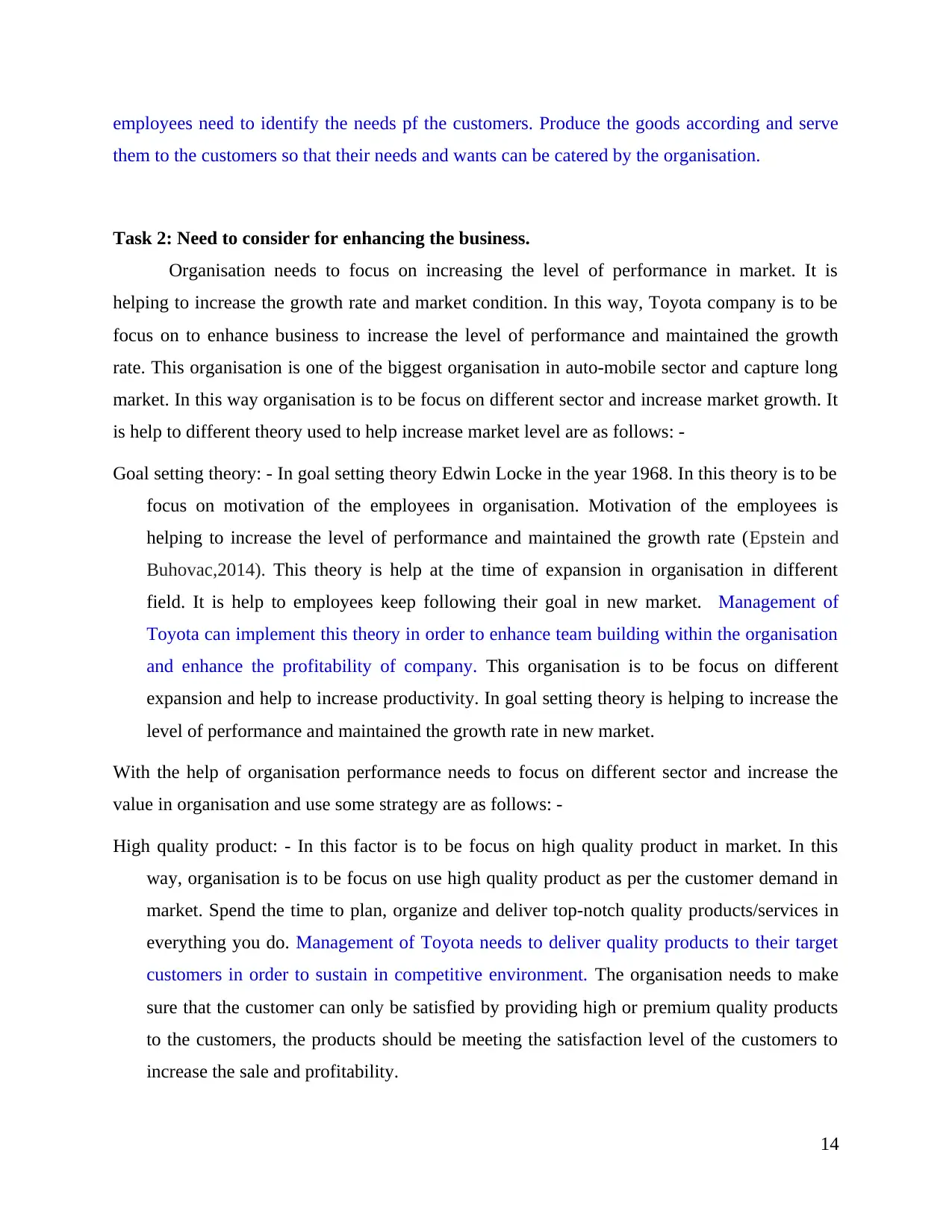
employees need to identify the needs pf the customers. Produce the goods according and serve
them to the customers so that their needs and wants can be catered by the organisation.
Task 2: Need to consider for enhancing the business.
Organisation needs to focus on increasing the level of performance in market. It is
helping to increase the growth rate and market condition. In this way, Toyota company is to be
focus on to enhance business to increase the level of performance and maintained the growth
rate. This organisation is one of the biggest organisation in auto-mobile sector and capture long
market. In this way organisation is to be focus on different sector and increase market growth. It
is help to different theory used to help increase market level are as follows: -
Goal setting theory: - In goal setting theory Edwin Locke in the year 1968. In this theory is to be
focus on motivation of the employees in organisation. Motivation of the employees is
helping to increase the level of performance and maintained the growth rate (Epstein and
Buhovac,2014). This theory is help at the time of expansion in organisation in different
field. It is help to employees keep following their goal in new market. Management of
Toyota can implement this theory in order to enhance team building within the organisation
and enhance the profitability of company. This organisation is to be focus on different
expansion and help to increase productivity. In goal setting theory is helping to increase the
level of performance and maintained the growth rate in new market.
With the help of organisation performance needs to focus on different sector and increase the
value in organisation and use some strategy are as follows: -
High quality product: - In this factor is to be focus on high quality product in market. In this
way, organisation is to be focus on use high quality product as per the customer demand in
market. Spend the time to plan, organize and deliver top-notch quality products/services in
everything you do. Management of Toyota needs to deliver quality products to their target
customers in order to sustain in competitive environment. The organisation needs to make
sure that the customer can only be satisfied by providing high or premium quality products
to the customers, the products should be meeting the satisfaction level of the customers to
increase the sale and profitability.
14
them to the customers so that their needs and wants can be catered by the organisation.
Task 2: Need to consider for enhancing the business.
Organisation needs to focus on increasing the level of performance in market. It is
helping to increase the growth rate and market condition. In this way, Toyota company is to be
focus on to enhance business to increase the level of performance and maintained the growth
rate. This organisation is one of the biggest organisation in auto-mobile sector and capture long
market. In this way organisation is to be focus on different sector and increase market growth. It
is help to different theory used to help increase market level are as follows: -
Goal setting theory: - In goal setting theory Edwin Locke in the year 1968. In this theory is to be
focus on motivation of the employees in organisation. Motivation of the employees is
helping to increase the level of performance and maintained the growth rate (Epstein and
Buhovac,2014). This theory is help at the time of expansion in organisation in different
field. It is help to employees keep following their goal in new market. Management of
Toyota can implement this theory in order to enhance team building within the organisation
and enhance the profitability of company. This organisation is to be focus on different
expansion and help to increase productivity. In goal setting theory is helping to increase the
level of performance and maintained the growth rate in new market.
With the help of organisation performance needs to focus on different sector and increase the
value in organisation and use some strategy are as follows: -
High quality product: - In this factor is to be focus on high quality product in market. In this
way, organisation is to be focus on use high quality product as per the customer demand in
market. Spend the time to plan, organize and deliver top-notch quality products/services in
everything you do. Management of Toyota needs to deliver quality products to their target
customers in order to sustain in competitive environment. The organisation needs to make
sure that the customer can only be satisfied by providing high or premium quality products
to the customers, the products should be meeting the satisfaction level of the customers to
increase the sale and profitability.
14
Paraphrase This Document
Need a fresh take? Get an instant paraphrase of this document with our AI Paraphraser
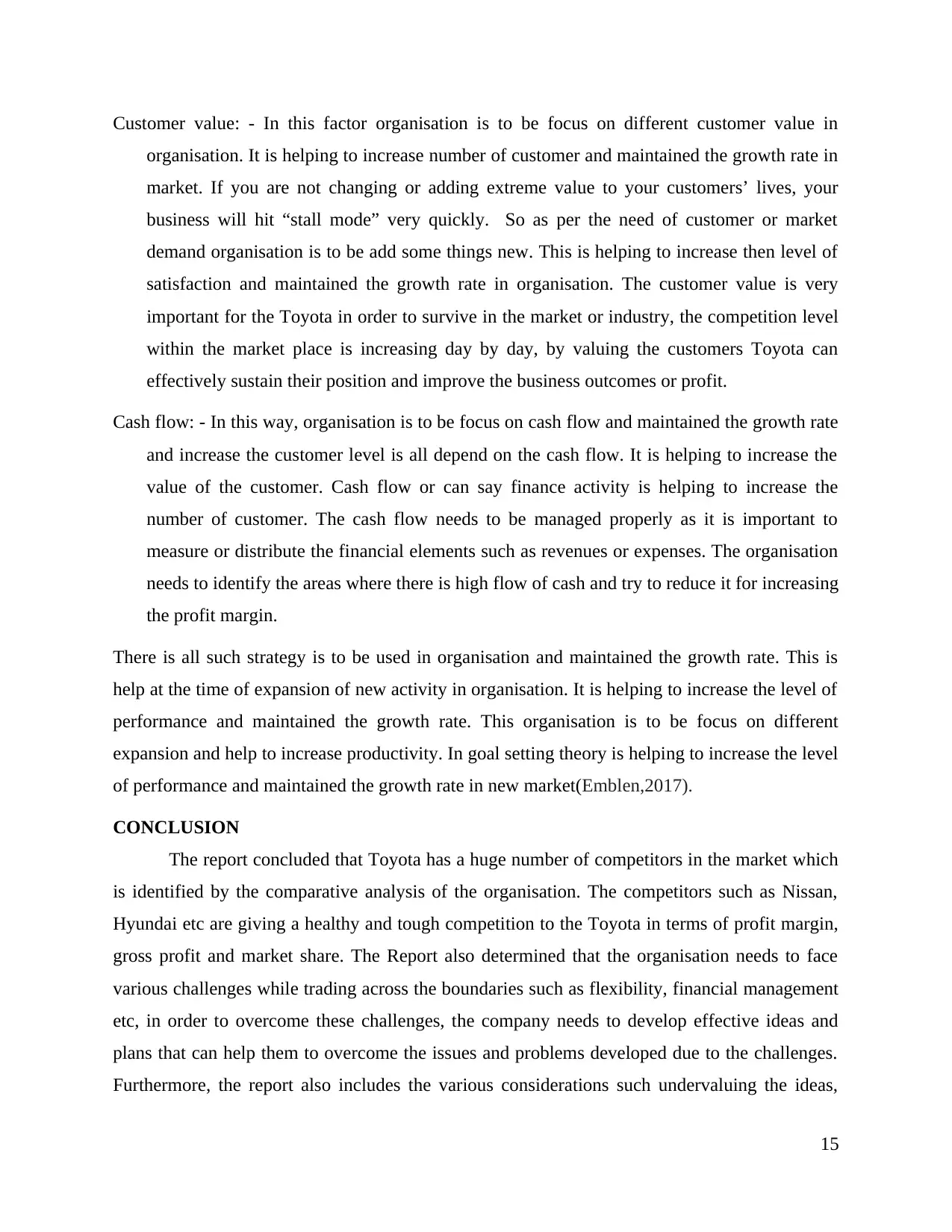
Customer value: - In this factor organisation is to be focus on different customer value in
organisation. It is helping to increase number of customer and maintained the growth rate in
market. If you are not changing or adding extreme value to your customers’ lives, your
business will hit “stall mode” very quickly. So as per the need of customer or market
demand organisation is to be add some things new. This is helping to increase then level of
satisfaction and maintained the growth rate in organisation. The customer value is very
important for the Toyota in order to survive in the market or industry, the competition level
within the market place is increasing day by day, by valuing the customers Toyota can
effectively sustain their position and improve the business outcomes or profit.
Cash flow: - In this way, organisation is to be focus on cash flow and maintained the growth rate
and increase the customer level is all depend on the cash flow. It is helping to increase the
value of the customer. Cash flow or can say finance activity is helping to increase the
number of customer. The cash flow needs to be managed properly as it is important to
measure or distribute the financial elements such as revenues or expenses. The organisation
needs to identify the areas where there is high flow of cash and try to reduce it for increasing
the profit margin.
There is all such strategy is to be used in organisation and maintained the growth rate. This is
help at the time of expansion of new activity in organisation. It is helping to increase the level of
performance and maintained the growth rate. This organisation is to be focus on different
expansion and help to increase productivity. In goal setting theory is helping to increase the level
of performance and maintained the growth rate in new market(Emblen,2017).
CONCLUSION
The report concluded that Toyota has a huge number of competitors in the market which
is identified by the comparative analysis of the organisation. The competitors such as Nissan,
Hyundai etc are giving a healthy and tough competition to the Toyota in terms of profit margin,
gross profit and market share. The Report also determined that the organisation needs to face
various challenges while trading across the boundaries such as flexibility, financial management
etc, in order to overcome these challenges, the company needs to develop effective ideas and
plans that can help them to overcome the issues and problems developed due to the challenges.
Furthermore, the report also includes the various considerations such undervaluing the ideas,
15
organisation. It is helping to increase number of customer and maintained the growth rate in
market. If you are not changing or adding extreme value to your customers’ lives, your
business will hit “stall mode” very quickly. So as per the need of customer or market
demand organisation is to be add some things new. This is helping to increase then level of
satisfaction and maintained the growth rate in organisation. The customer value is very
important for the Toyota in order to survive in the market or industry, the competition level
within the market place is increasing day by day, by valuing the customers Toyota can
effectively sustain their position and improve the business outcomes or profit.
Cash flow: - In this way, organisation is to be focus on cash flow and maintained the growth rate
and increase the customer level is all depend on the cash flow. It is helping to increase the
value of the customer. Cash flow or can say finance activity is helping to increase the
number of customer. The cash flow needs to be managed properly as it is important to
measure or distribute the financial elements such as revenues or expenses. The organisation
needs to identify the areas where there is high flow of cash and try to reduce it for increasing
the profit margin.
There is all such strategy is to be used in organisation and maintained the growth rate. This is
help at the time of expansion of new activity in organisation. It is helping to increase the level of
performance and maintained the growth rate. This organisation is to be focus on different
expansion and help to increase productivity. In goal setting theory is helping to increase the level
of performance and maintained the growth rate in new market(Emblen,2017).
CONCLUSION
The report concluded that Toyota has a huge number of competitors in the market which
is identified by the comparative analysis of the organisation. The competitors such as Nissan,
Hyundai etc are giving a healthy and tough competition to the Toyota in terms of profit margin,
gross profit and market share. The Report also determined that the organisation needs to face
various challenges while trading across the boundaries such as flexibility, financial management
etc, in order to overcome these challenges, the company needs to develop effective ideas and
plans that can help them to overcome the issues and problems developed due to the challenges.
Furthermore, the report also includes the various considerations such undervaluing the ideas,
15
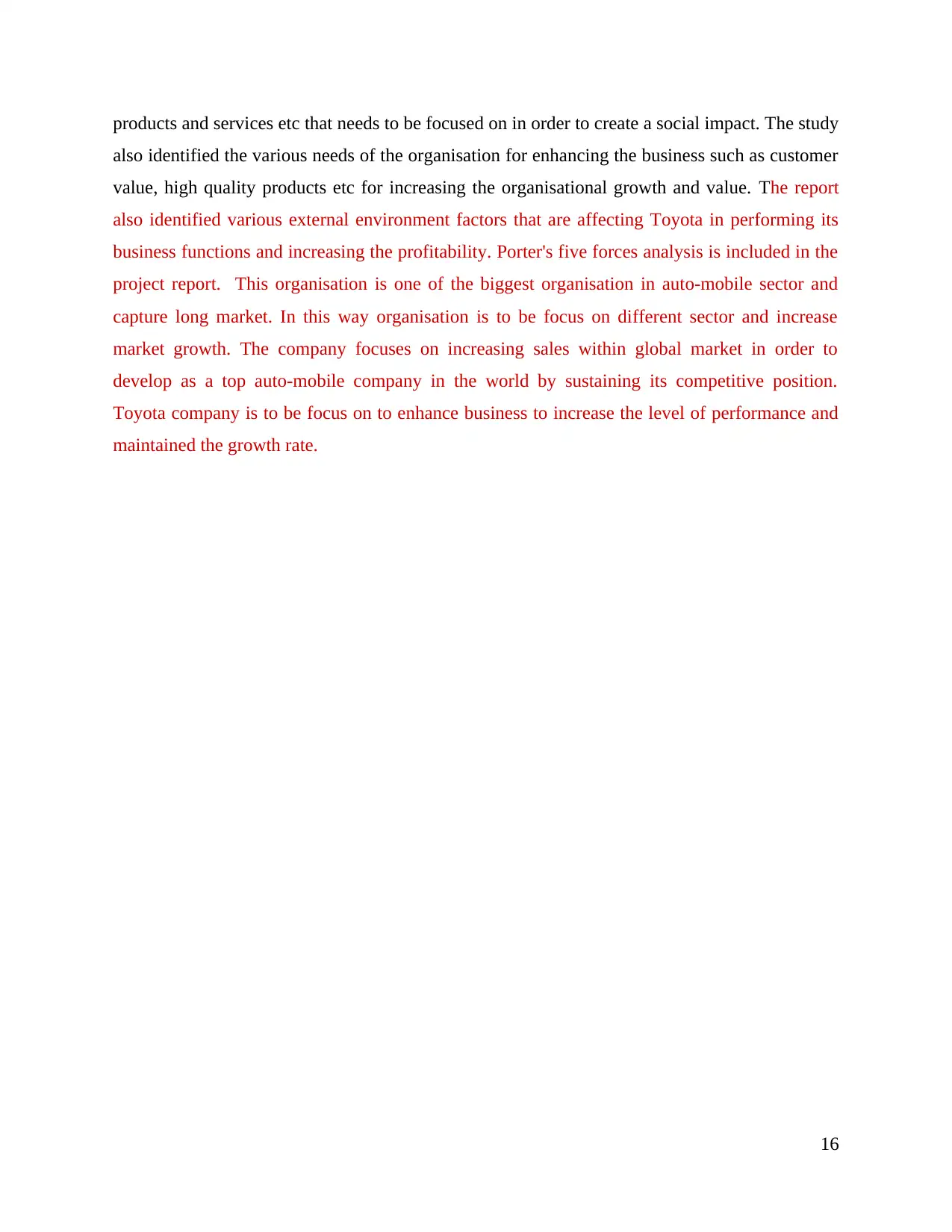
products and services etc that needs to be focused on in order to create a social impact. The study
also identified the various needs of the organisation for enhancing the business such as customer
value, high quality products etc for increasing the organisational growth and value. The report
also identified various external environment factors that are affecting Toyota in performing its
business functions and increasing the profitability. Porter's five forces analysis is included in the
project report. This organisation is one of the biggest organisation in auto-mobile sector and
capture long market. In this way organisation is to be focus on different sector and increase
market growth. The company focuses on increasing sales within global market in order to
develop as a top auto-mobile company in the world by sustaining its competitive position.
Toyota company is to be focus on to enhance business to increase the level of performance and
maintained the growth rate.
16
also identified the various needs of the organisation for enhancing the business such as customer
value, high quality products etc for increasing the organisational growth and value. The report
also identified various external environment factors that are affecting Toyota in performing its
business functions and increasing the profitability. Porter's five forces analysis is included in the
project report. This organisation is one of the biggest organisation in auto-mobile sector and
capture long market. In this way organisation is to be focus on different sector and increase
market growth. The company focuses on increasing sales within global market in order to
develop as a top auto-mobile company in the world by sustaining its competitive position.
Toyota company is to be focus on to enhance business to increase the level of performance and
maintained the growth rate.
16
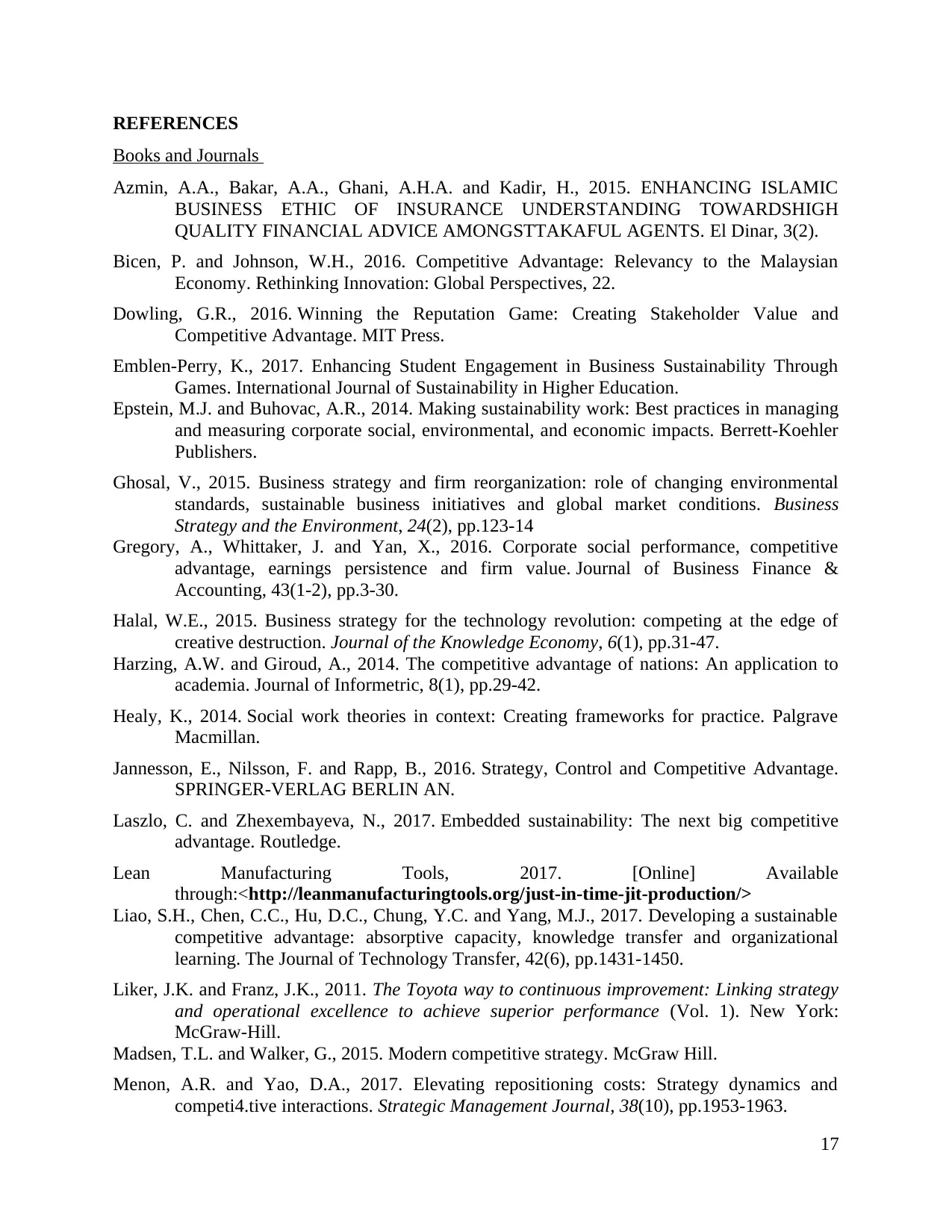
REFERENCES
Books and Journals
Azmin, A.A., Bakar, A.A., Ghani, A.H.A. and Kadir, H., 2015. ENHANCING ISLAMIC
BUSINESS ETHIC OF INSURANCE UNDERSTANDING TOWARDSHIGH
QUALITY FINANCIAL ADVICE AMONGSTTAKAFUL AGENTS. El Dinar, 3(2).
Bicen, P. and Johnson, W.H., 2016. Competitive Advantage: Relevancy to the Malaysian
Economy. Rethinking Innovation: Global Perspectives, 22.
Dowling, G.R., 2016. Winning the Reputation Game: Creating Stakeholder Value and
Competitive Advantage. MIT Press.
Emblen-Perry, K., 2017. Enhancing Student Engagement in Business Sustainability Through
Games. International Journal of Sustainability in Higher Education.
Epstein, M.J. and Buhovac, A.R., 2014. Making sustainability work: Best practices in managing
and measuring corporate social, environmental, and economic impacts. Berrett-Koehler
Publishers.
Ghosal, V., 2015. Business strategy and firm reorganization: role of changing environmental
standards, sustainable business initiatives and global market conditions. Business
Strategy and the Environment, 24(2), pp.123-14
Gregory, A., Whittaker, J. and Yan, X., 2016. Corporate social performance, competitive
advantage, earnings persistence and firm value. Journal of Business Finance &
Accounting, 43(1-2), pp.3-30.
Halal, W.E., 2015. Business strategy for the technology revolution: competing at the edge of
creative destruction. Journal of the Knowledge Economy, 6(1), pp.31-47.
Harzing, A.W. and Giroud, A., 2014. The competitive advantage of nations: An application to
academia. Journal of Informetric, 8(1), pp.29-42.
Healy, K., 2014. Social work theories in context: Creating frameworks for practice. Palgrave
Macmillan.
Jannesson, E., Nilsson, F. and Rapp, B., 2016. Strategy, Control and Competitive Advantage.
SPRINGER-VERLAG BERLIN AN.
Laszlo, C. and Zhexembayeva, N., 2017. Embedded sustainability: The next big competitive
advantage. Routledge.
Lean Manufacturing Tools, 2017. [Online] Available
through:<http://leanmanufacturingtools.org/just-in-time-jit-production/>
Liao, S.H., Chen, C.C., Hu, D.C., Chung, Y.C. and Yang, M.J., 2017. Developing a sustainable
competitive advantage: absorptive capacity, knowledge transfer and organizational
learning. The Journal of Technology Transfer, 42(6), pp.1431-1450.
Liker, J.K. and Franz, J.K., 2011. The Toyota way to continuous improvement: Linking strategy
and operational excellence to achieve superior performance (Vol. 1). New York:
McGraw-Hill.
Madsen, T.L. and Walker, G., 2015. Modern competitive strategy. McGraw Hill.
Menon, A.R. and Yao, D.A., 2017. Elevating repositioning costs: Strategy dynamics and
competi4.tive interactions. Strategic Management Journal, 38(10), pp.1953-1963.
17
Books and Journals
Azmin, A.A., Bakar, A.A., Ghani, A.H.A. and Kadir, H., 2015. ENHANCING ISLAMIC
BUSINESS ETHIC OF INSURANCE UNDERSTANDING TOWARDSHIGH
QUALITY FINANCIAL ADVICE AMONGSTTAKAFUL AGENTS. El Dinar, 3(2).
Bicen, P. and Johnson, W.H., 2016. Competitive Advantage: Relevancy to the Malaysian
Economy. Rethinking Innovation: Global Perspectives, 22.
Dowling, G.R., 2016. Winning the Reputation Game: Creating Stakeholder Value and
Competitive Advantage. MIT Press.
Emblen-Perry, K., 2017. Enhancing Student Engagement in Business Sustainability Through
Games. International Journal of Sustainability in Higher Education.
Epstein, M.J. and Buhovac, A.R., 2014. Making sustainability work: Best practices in managing
and measuring corporate social, environmental, and economic impacts. Berrett-Koehler
Publishers.
Ghosal, V., 2015. Business strategy and firm reorganization: role of changing environmental
standards, sustainable business initiatives and global market conditions. Business
Strategy and the Environment, 24(2), pp.123-14
Gregory, A., Whittaker, J. and Yan, X., 2016. Corporate social performance, competitive
advantage, earnings persistence and firm value. Journal of Business Finance &
Accounting, 43(1-2), pp.3-30.
Halal, W.E., 2015. Business strategy for the technology revolution: competing at the edge of
creative destruction. Journal of the Knowledge Economy, 6(1), pp.31-47.
Harzing, A.W. and Giroud, A., 2014. The competitive advantage of nations: An application to
academia. Journal of Informetric, 8(1), pp.29-42.
Healy, K., 2014. Social work theories in context: Creating frameworks for practice. Palgrave
Macmillan.
Jannesson, E., Nilsson, F. and Rapp, B., 2016. Strategy, Control and Competitive Advantage.
SPRINGER-VERLAG BERLIN AN.
Laszlo, C. and Zhexembayeva, N., 2017. Embedded sustainability: The next big competitive
advantage. Routledge.
Lean Manufacturing Tools, 2017. [Online] Available
through:<http://leanmanufacturingtools.org/just-in-time-jit-production/>
Liao, S.H., Chen, C.C., Hu, D.C., Chung, Y.C. and Yang, M.J., 2017. Developing a sustainable
competitive advantage: absorptive capacity, knowledge transfer and organizational
learning. The Journal of Technology Transfer, 42(6), pp.1431-1450.
Liker, J.K. and Franz, J.K., 2011. The Toyota way to continuous improvement: Linking strategy
and operational excellence to achieve superior performance (Vol. 1). New York:
McGraw-Hill.
Madsen, T.L. and Walker, G., 2015. Modern competitive strategy. McGraw Hill.
Menon, A.R. and Yao, D.A., 2017. Elevating repositioning costs: Strategy dynamics and
competi4.tive interactions. Strategic Management Journal, 38(10), pp.1953-1963.
17
Secure Best Marks with AI Grader
Need help grading? Try our AI Grader for instant feedback on your assignments.
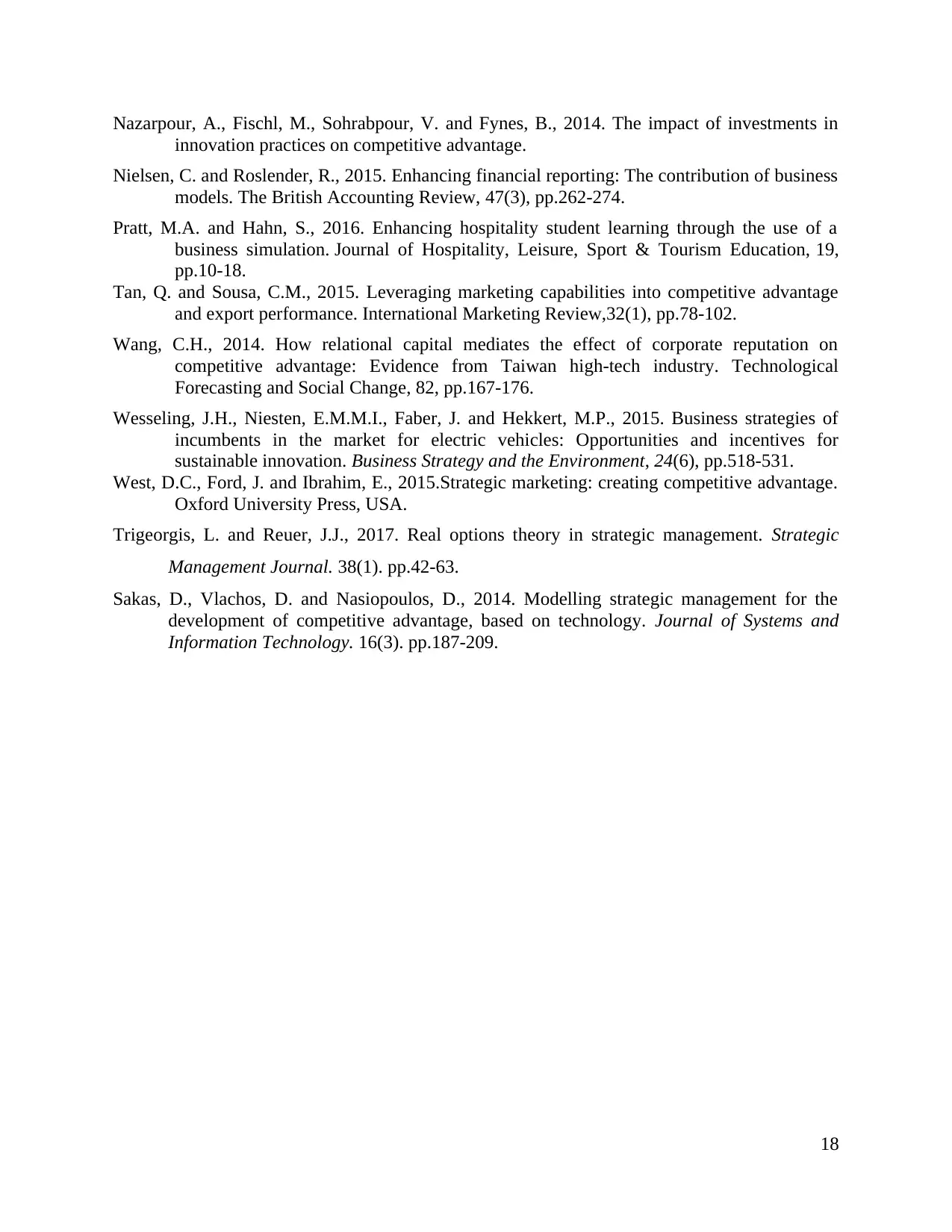
Nazarpour, A., Fischl, M., Sohrabpour, V. and Fynes, B., 2014. The impact of investments in
innovation practices on competitive advantage.
Nielsen, C. and Roslender, R., 2015. Enhancing financial reporting: The contribution of business
models. The British Accounting Review, 47(3), pp.262-274.
Pratt, M.A. and Hahn, S., 2016. Enhancing hospitality student learning through the use of a
business simulation. Journal of Hospitality, Leisure, Sport & Tourism Education, 19,
pp.10-18.
Tan, Q. and Sousa, C.M., 2015. Leveraging marketing capabilities into competitive advantage
and export performance. International Marketing Review,32(1), pp.78-102.
Wang, C.H., 2014. How relational capital mediates the effect of corporate reputation on
competitive advantage: Evidence from Taiwan high-tech industry. Technological
Forecasting and Social Change, 82, pp.167-176.
Wesseling, J.H., Niesten, E.M.M.I., Faber, J. and Hekkert, M.P., 2015. Business strategies of
incumbents in the market for electric vehicles: Opportunities and incentives for
sustainable innovation. Business Strategy and the Environment, 24(6), pp.518-531.
West, D.C., Ford, J. and Ibrahim, E., 2015.Strategic marketing: creating competitive advantage.
Oxford University Press, USA.
Trigeorgis, L. and Reuer, J.J., 2017. Real options theory in strategic management. Strategic
Management Journal. 38(1). pp.42-63.
Sakas, D., Vlachos, D. and Nasiopoulos, D., 2014. Modelling strategic management for the
development of competitive advantage, based on technology. Journal of Systems and
Information Technology. 16(3). pp.187-209.
18
innovation practices on competitive advantage.
Nielsen, C. and Roslender, R., 2015. Enhancing financial reporting: The contribution of business
models. The British Accounting Review, 47(3), pp.262-274.
Pratt, M.A. and Hahn, S., 2016. Enhancing hospitality student learning through the use of a
business simulation. Journal of Hospitality, Leisure, Sport & Tourism Education, 19,
pp.10-18.
Tan, Q. and Sousa, C.M., 2015. Leveraging marketing capabilities into competitive advantage
and export performance. International Marketing Review,32(1), pp.78-102.
Wang, C.H., 2014. How relational capital mediates the effect of corporate reputation on
competitive advantage: Evidence from Taiwan high-tech industry. Technological
Forecasting and Social Change, 82, pp.167-176.
Wesseling, J.H., Niesten, E.M.M.I., Faber, J. and Hekkert, M.P., 2015. Business strategies of
incumbents in the market for electric vehicles: Opportunities and incentives for
sustainable innovation. Business Strategy and the Environment, 24(6), pp.518-531.
West, D.C., Ford, J. and Ibrahim, E., 2015.Strategic marketing: creating competitive advantage.
Oxford University Press, USA.
Trigeorgis, L. and Reuer, J.J., 2017. Real options theory in strategic management. Strategic
Management Journal. 38(1). pp.42-63.
Sakas, D., Vlachos, D. and Nasiopoulos, D., 2014. Modelling strategic management for the
development of competitive advantage, based on technology. Journal of Systems and
Information Technology. 16(3). pp.187-209.
18
1 out of 20
Related Documents
Your All-in-One AI-Powered Toolkit for Academic Success.
+13062052269
info@desklib.com
Available 24*7 on WhatsApp / Email
![[object Object]](/_next/static/media/star-bottom.7253800d.svg)
Unlock your academic potential
© 2024 | Zucol Services PVT LTD | All rights reserved.





